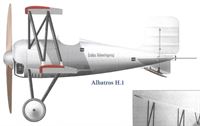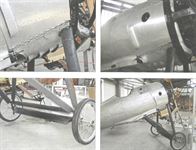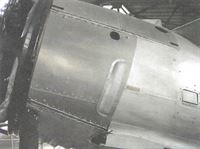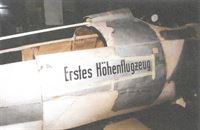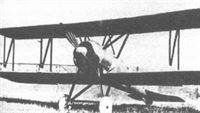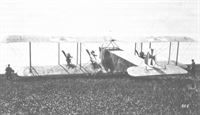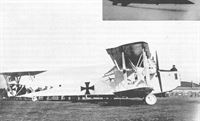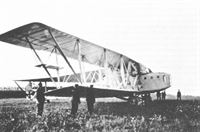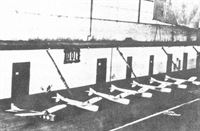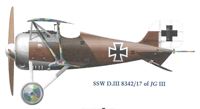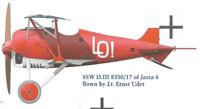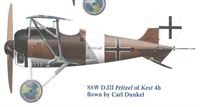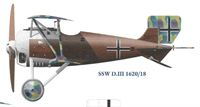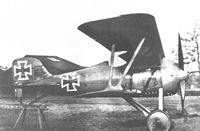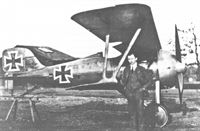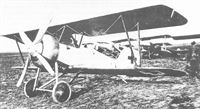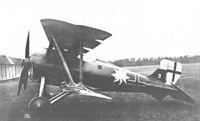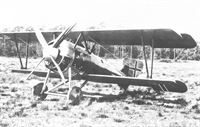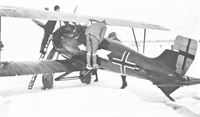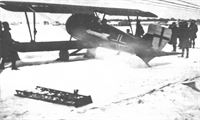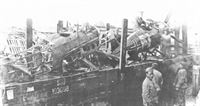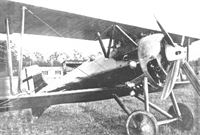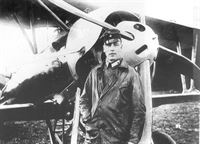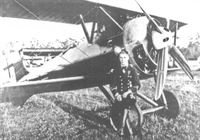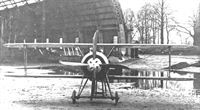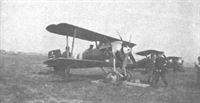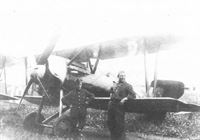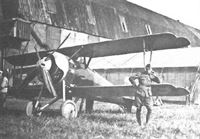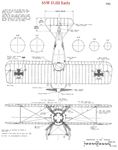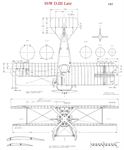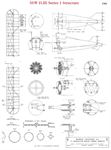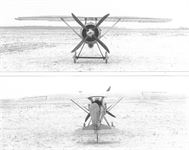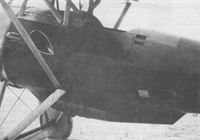Книги
Centennial Perspective
J.Herris
Siemens-Schuckert Aircraft of World War I
327
J.Herris - Siemens-Schuckert Aircraft of World War I /Centennial Perspective/ (12)
An Albatros C.IIIc(SSW) in front of the SSW factory (logo near peak of roof) at Nurnberg in 1917. When production of the SSW D.I was cancelled, SSW was left with unused production capacity and in late 1917 was assigned to produce the Albatros C.IIIc under license as the Albatros C.IIIc(SSW). One hundred aircaft, 14000-14099/17 were ordered and 93 had been delivered by December 1918 when production stopped. Similarly, a contract for 100 LVG B.III (SSW) trainers, 2300-2399/18, was awarded to SSW in August 1918, and two were under construction at the Armistice.
An Albatros D.III and a 500 kg SSW torpedo glider beneath Zeppelin L.35 on Jan. 26, 1918. This was the first time an airplane was launched from an airship.
Details of the restored Albatros H.1, a SSW D.IV rebuilt with extended-span wings for high-altitude flight tests postwar, in the museum at Krakow.
Details of the restored Albatros H.1, a SSW D.IV rebuilt postwar for high-altitude flight tests, in the museum at Krakow.
Erstes Hohenflugzeug (First High-Altitude Aircraft) was painted on both sides of the aircraft as shown here prior to restoration.
The Albatros H.1, a SSW D.IV that was rebuilt postwar for high-altitude flight tests with larger wing and revised tail surfaces.
The SSW D.III was powered by the same 205 hp Siemens-Halske Sh.III used in the Pfalz D.VIII; the SSW D.III had similar performance but was more maneuverable than the Pfalz D.VIII. These photos show early production SSW D.III 8346/17 from the first production batch assigned to Lt. Walter Goettsch, then Staffel fuhrer of Jasta 19. It has the large spinner, full cowling, and inset aerodynamic balances of the first D.III production batch. Fokker Triplanes are lined up in the background.
SSW D.III 8346/17. Jasta 19 at Balatre, April 20, 1918. Fokker Triplanes are lined up in the background.
An early-production D.III at Jasta 19. The full image at the top shows a triplane undergoing maintenance. The enlargement below shows another SSW D.III in the background.
An early-production D.III at Jasta 19 undergoing engine maintenance with spinner and cowling removed. A Jasta 19 Fokker Dr.I is at left.
The SSW factory producing D.III fighters and Gotha G.IV(SSW) bombers; 80 Gothas were built under license.
Pre-War & Early War SSW Aircraft
The first SSW airplane was a biplane based on the Wright Flyer. Powered by a 50 hp Argus engine, it was built in 1909 and first flew on December 31, 1909. Damaged on landing after this flight, it was modified and flew again on March 9, 1910 carrying its designer, Bourcart, and one passenger. On March 11 it flew for a kilometer with three people aboard, but crashed when caught in a cross-wind. The next SSW design was a high-wing monoplane first flown in May 1911. A primitive design, it was not successful. A second monoplane to the Bleriot configuration was completed in September 1911, but its failure caused SSW to temporarily abandon aviation.
SSW "Bulldog"
Shortly before the war Swedish designer Villehad Forssman, who had an office in Berlin, designed a monoplane known as the Bulldog for Prince Friedrich Sigismund of Prussia. Soon after the war started, Forssman offered SSW his design. The War Ministry desperately needed warplanes, and with their support SSW hired Forssman to supervise construction of two of his Bulldogs for reconnaissance. SSW began assembly of the aircraft at their Dynamo Works in their community of Siemensstadt.
The first Bulldog, built in late 1914, was powered by a 100 hp Mercedes D.I in-line, six-cylinder engine. The second Bulldog, powered by one of the first 110 hp Siemens-Halske Sh.I counter-rotary engines, first flew on April 18, 1915. Both featured side-by-side seating for two crewmen. Both Bulldogs were rejected by the Army for mediocre flying qualities and poor performance. After modification, the rotary-powered Bulldog was used for air-launching trials for models of the missiles SSW was developing.
The first SSW airplane was a biplane based on the Wright Flyer. Powered by a 50 hp Argus engine, it was built in 1909 and first flew on December 31, 1909. Damaged on landing after this flight, it was modified and flew again on March 9, 1910 carrying its designer, Bourcart, and one passenger. On March 11 it flew for a kilometer with three people aboard, but crashed when caught in a cross-wind. The next SSW design was a high-wing monoplane first flown in May 1911. A primitive design, it was not successful. A second monoplane to the Bleriot configuration was completed in September 1911, but its failure caused SSW to temporarily abandon aviation.
SSW "Bulldog"
Shortly before the war Swedish designer Villehad Forssman, who had an office in Berlin, designed a monoplane known as the Bulldog for Prince Friedrich Sigismund of Prussia. Soon after the war started, Forssman offered SSW his design. The War Ministry desperately needed warplanes, and with their support SSW hired Forssman to supervise construction of two of his Bulldogs for reconnaissance. SSW began assembly of the aircraft at their Dynamo Works in their community of Siemensstadt.
The first Bulldog, built in late 1914, was powered by a 100 hp Mercedes D.I in-line, six-cylinder engine. The second Bulldog, powered by one of the first 110 hp Siemens-Halske Sh.I counter-rotary engines, first flew on April 18, 1915. Both featured side-by-side seating for two crewmen. Both Bulldogs were rejected by the Army for mediocre flying qualities and poor performance. After modification, the rotary-powered Bulldog was used for air-launching trials for models of the missiles SSW was developing.
The Siemens Schuckert Bulldogge. The caption on the photo give it as 'Bulldogg-Eindecker des Prinzen Friedrich Sigismund'
View of the "Bulldog" monoplane Forssman designed and built for Prince Friedrich Sigismund of Prussia. The royal crest was applied to the rudder. Engine was a Mercedes. At the underside of the wing is written 80 PFS (Pferde Starke = Horsepower).
Forssman's 100 hp Mercedes D.I-powered "Bulldog" with Forssman standing in front of it; the vertical tail has been enlarged from the aircraft for Prince Sigismund. This aircraft and the other "Bulldog" powered by a 110 hp Siemens-Halske Sh.I counter-rotary engine were both rejected by the Army for poor performance and mediocre flying qualities.
Another view of a test glider mounted under the modified, rotary-powered SSW Bulldog before a test launch.
After being modified to eliminate its protruding belly, the SSW Bulldog, powered by one of the first 110 hp Siemens-Halske Sh.I counter-rotary engines, was used to launch scale gliders to develop shapes for the SSW guided missile program.
SSW B.I
In the summer of 1915 brothers Bruno and Franz Steffen, both famous pre-war pilots and aircraft builders who joined SSW in December 1914, began designing single-engine military aircraft. The B.I was a two-seat reconnaissance aircraft powered by a 110 hp Siemens-Halske Sh.I and was the only one of these designs that was not a fighter. The B.I two- bay biplane achieved 95 mph, a good speed for the time, and was sent to BAO (Brieftauben Abteilung Ostende - Carrier Pigeon Section Ostend), a code name for one of Germany's original bombing units, at the request of its commander, Freiherr von Thuna. The only B.I built, it crashed in November 1915 and was not repaired.
In the summer of 1915 brothers Bruno and Franz Steffen, both famous pre-war pilots and aircraft builders who joined SSW in December 1914, began designing single-engine military aircraft. The B.I was a two-seat reconnaissance aircraft powered by a 110 hp Siemens-Halske Sh.I and was the only one of these designs that was not a fighter. The B.I two- bay biplane achieved 95 mph, a good speed for the time, and was sent to BAO (Brieftauben Abteilung Ostende - Carrier Pigeon Section Ostend), a code name for one of Germany's original bombing units, at the request of its commander, Freiherr von Thuna. The only B.I built, it crashed in November 1915 and was not repaired.
The SSW B.I reconnaissance biplane. It was a neat, two-bay design for two crewmen. Engine was a 110 hp Sh.I counter-rotary. No armament was fitted.
View of the SSW B.I. The 110 hp Sh.I counter-rotary required a front bearing support. The Siemens-Schuckert company logo is on the hangar doors below.
This view of the SSW B.I reconnaissance biplane reveal that the fuselage and tail were closely related to those of the SSW E.I monoplane fighter. The only B.I built was sent to BAO at the request of its commander, where it crashed in November 1915.
SSW DD 5
Designed by Franz Steffen, the SSW DD 5 was basically an E.I airframe with a biplane wing cellule, and was SSW's first biplane fighter. Power remained a 110 hp Siemens-Halske Sh.I counter-rotary engine, and a single synchronized machine gun was fitted. Tubular steel was used for the wing spars and I-struts. Tested in August 1916, it was rejected because of poor field of view for the pilot and poor handling qualities. Development then focused on the SSW D.I.
Unusually for a WWI aircraft, the DD 5's wing planform tapered from the fuselage to the wing tips,- most WWI featured wings of rectangular planform as seen in the SSW E-types. Tapered wings are more efficient because they generate less induced drag (drag induced by creating lift, which generates vortices at the wing tips) and also reduce weight, which is likely why the designer used taper.
However, tapered wings aggravate the tendency of the wing to stall first at the tips. Since the ailerons are normally fitted at the tips of the wings for greatest effectiveness, the tendency of the wing to stall first at the tips is very dangerous because it robs the pilot of roll control in a critical situation, increasing the likelihood of the aircraft entering an unintended spin. Most designers of the time 'washed out' the angle of incidence at the wing tips to prevent the wing from stalling at the tip first, and more sophisticated means were developed later to prevent tip stall. However, a look at the DD 5 shows no evidence of any aerodynamic measures designed into the wing to alleviate the tip stall problem, undoubtedly resulting in poor handling near stalling speed.
Designed by Franz Steffen, the SSW DD 5 was basically an E.I airframe with a biplane wing cellule, and was SSW's first biplane fighter. Power remained a 110 hp Siemens-Halske Sh.I counter-rotary engine, and a single synchronized machine gun was fitted. Tubular steel was used for the wing spars and I-struts. Tested in August 1916, it was rejected because of poor field of view for the pilot and poor handling qualities. Development then focused on the SSW D.I.
Unusually for a WWI aircraft, the DD 5's wing planform tapered from the fuselage to the wing tips,- most WWI featured wings of rectangular planform as seen in the SSW E-types. Tapered wings are more efficient because they generate less induced drag (drag induced by creating lift, which generates vortices at the wing tips) and also reduce weight, which is likely why the designer used taper.
However, tapered wings aggravate the tendency of the wing to stall first at the tips. Since the ailerons are normally fitted at the tips of the wings for greatest effectiveness, the tendency of the wing to stall first at the tips is very dangerous because it robs the pilot of roll control in a critical situation, increasing the likelihood of the aircraft entering an unintended spin. Most designers of the time 'washed out' the angle of incidence at the wing tips to prevent the wing from stalling at the tip first, and more sophisticated means were developed later to prevent tip stall. However, a look at the DD 5 shows no evidence of any aerodynamic measures designed into the wing to alleviate the tip stall problem, undoubtedly resulting in poor handling near stalling speed.
SSW E.I
The SSW E.I was completed in October 1915 and finished its tests on March 17, 1916. Of conventional wire-braced wood construction with fabric-covered wings and ply-covered fuselage, it was recommended for production and an order for 20 aircraft, 550-569/15, was placed by Idflieg. Production was undertaken by the SSW Transformer Works in Nurnberg. The E.I was fitted with one synchronized machine gun. Eight E.Is were powered by the 90 hp Sh.O and the remainder by the 110 hp Sh.I. An additional airframe was powered by a 120 hp Argus As.II, becoming the sole SSW E.II. Like the Fokker designs, it used wing-warping instead of conventional ailerons for roll control. Unfortunately, the SSW monoplanes arrived after the D.H.2 and Nieuport 11 had established technical superiority over the early monoplane designs and were too late to make an impact.
SSW E.I Specifications
Engine: 110 hp Siemens-Halske Sh.I
Wing: Span 10.00 m
Area 16.0 m2
General: Length 7.10 m
Height 2.80 m
Empty Weight 473 kg
Loaded Weight 673 kg
Maximum Speed: 140 km/h
SSW E.II
The SSW E.II was essentially an E.I airframe powered by an in-line 120 hp Argus As.II engine; like the E.I it carried a single machine gun. The one prototype built first flew in early 1916. Its designer, Franz Steffen, suffered a fatal crash in the E.II while demonstrating it at Doberitz on June 26, 1916.
SSW E.III & E.IV
Ordered in April 1916, the SSW E.III was an E.I airframe with a 100 hp Oberursel; again one synchronized gun was carried. Six aircraft, 620-625/16, were built. A derivative of the E.III was proposed with a circular fuselage; known as the E.IV, it remained a project.
Siemens-Schuckert Monoplane Fighter Specifications
E.I E.II E.III D.VI
Engine 110 hp Sh.I 120 hp As.II 100 hp Oberursel U.I 205 hp Sh.IIIa
Armament One MG One MG One MG Two MG *
Span 10.00 m — 7.10 m 9.37 m
Length 7.10 m — 7.10 m 6.50 m
Height 2.80 m — 2.80 m 2.72 m
Wing Area 16.0 m2 — 16.0 m2 12.46 m2
Empty Weight 473 kg — 478 kg 540 kg
Loaded Weight 673 kg — 678 kg 710 kg
Maximum Speed: 140 km/h — — 220 km/h (@ 2,000m)
Climb: 6,000m NA — — 16 minutes
7,000m NA — — 22 minutes
Ceiling: — — — 8,000m
Notes: 1. E.II dimensions similar to E.I except length.
2. SSW D.VI armament is that projected for production; the two prototypes were unarmed.
The SSW E.I was completed in October 1915 and finished its tests on March 17, 1916. Of conventional wire-braced wood construction with fabric-covered wings and ply-covered fuselage, it was recommended for production and an order for 20 aircraft, 550-569/15, was placed by Idflieg. Production was undertaken by the SSW Transformer Works in Nurnberg. The E.I was fitted with one synchronized machine gun. Eight E.Is were powered by the 90 hp Sh.O and the remainder by the 110 hp Sh.I. An additional airframe was powered by a 120 hp Argus As.II, becoming the sole SSW E.II. Like the Fokker designs, it used wing-warping instead of conventional ailerons for roll control. Unfortunately, the SSW monoplanes arrived after the D.H.2 and Nieuport 11 had established technical superiority over the early monoplane designs and were too late to make an impact.
SSW E.I Specifications
Engine: 110 hp Siemens-Halske Sh.I
Wing: Span 10.00 m
Area 16.0 m2
General: Length 7.10 m
Height 2.80 m
Empty Weight 473 kg
Loaded Weight 673 kg
Maximum Speed: 140 km/h
SSW E.II
The SSW E.II was essentially an E.I airframe powered by an in-line 120 hp Argus As.II engine; like the E.I it carried a single machine gun. The one prototype built first flew in early 1916. Its designer, Franz Steffen, suffered a fatal crash in the E.II while demonstrating it at Doberitz on June 26, 1916.
SSW E.III & E.IV
Ordered in April 1916, the SSW E.III was an E.I airframe with a 100 hp Oberursel; again one synchronized gun was carried. Six aircraft, 620-625/16, were built. A derivative of the E.III was proposed with a circular fuselage; known as the E.IV, it remained a project.
Siemens-Schuckert Monoplane Fighter Specifications
E.I E.II E.III D.VI
Engine 110 hp Sh.I 120 hp As.II 100 hp Oberursel U.I 205 hp Sh.IIIa
Armament One MG One MG One MG Two MG *
Span 10.00 m — 7.10 m 9.37 m
Length 7.10 m — 7.10 m 6.50 m
Height 2.80 m — 2.80 m 2.72 m
Wing Area 16.0 m2 — 16.0 m2 12.46 m2
Empty Weight 473 kg — 478 kg 540 kg
Loaded Weight 673 kg — 678 kg 710 kg
Maximum Speed: 140 km/h — — 220 km/h (@ 2,000m)
Climb: 6,000m NA — — 16 minutes
7,000m NA — — 22 minutes
Ceiling: — — — 8,000m
Notes: 1. E.II dimensions similar to E.I except length.
2. SSW D.VI armament is that projected for production; the two prototypes were unarmed.
The SSW E.I prototype designed by Franz Steffen featured a small spinner that was omitted from production aircraft. Like most Eindeckers one synchronized gun was carried and it was powered by a rotary engine, in this case either a 90 hp Sh.O (eight aircraft) or a 110 hp Siemens-Halske Sh.I counter-rotary engine (a dozen aircraft).
The SSW E.I prototype, identified by the small spinner, photographed at the SSW factory. By the time the SSW Eindeckers appeared the basic configuration and wing-warping instead of ailerons, was outdated. (The Peter M. Bowers Collection/The Museum of Flight)
The fuselage of the SSW E.I in front of the pilot was painted a dark color, probably to reduce glare.
The SSW E.I production aircraft dispensed with the small spinner fitted to the prototype. The E I achieved operational service in small numbers in the summer of 1916.
Another view of an SSW E.I production aircraft. The support structure for the front bearing needed by the Sh.I counter-rotary engine is clearly shown. (The Peter M. Bowers Collection/The Museum of Flight)
An SSW E.I production aircraft in flight. Although using the same configuration as the Fokker and Pfalz Eindeckers, the SSW E.I was much different in detail, and in particular the tail surfaces were distinctly different. Most of these airplanes were delivered directly to flying schools.
This close-up view of an SSW E.I fighter shows the gun installation in greater detail together with a closer view of the dark-painted anti-glare panel in front of the pilot.
SSW E.I fighters in production at the modern SSW factory. The SSW design was cleaner than the Fokker and Pfalz Eindeckers but was simply too late for important operational use at the front and most were delivered to single-seat flying schools.
A few SSW E.I fighters reached the front. These two are shown during construction in the factory, but by the time these reached the Front the Eindecker era was drawing to a close as higher-performance biplane fighters were appearing.
A few SSW E.I fighters reached the front. These two are shown during construction in the factory, but by the time these reached the Front the Eindecker era was drawing to a close as higher-performance biplane fighters were appearing.
SSW E.I fighter airframe undergoing static load testing at the SSW factory. The load had to be distributed along the wing to simulate flight loads. The sandbag method was used widely throughout the aviation industry for many years.
The sole SSW E.II prototype is shown in side view. The large exhaust for its in-line Argus engine is prominent. The SSW E.II was one of two Eindeckers to feature an in-line engine, the other being the Pfalz E.V.
The SSW E.II prototype designed by Franz Steffen was powered by a 120 hp Argus As.II engine. Like most Eindeckers, one synchronized gun was carried. (The Peter M. Bowers Collection/The Museum of Flight)
Rearview of the SSW E.II fighter prototype at the SSW factory. For an Eindecker the E.II was quite streamlined.
The SSW E.II prototype under construction. This view clearly shows the well-streamlined installation of the in-line 120 hp Argus As.II engine. (The Peter M. Bowers Collection/The Museum of Flight)
The fatal crash of Franz Steffen in the SSW E.II prototype he designed. Steffen was demonstrating the E.II at Doberitz on June 26, 1916 when he crashed.
SSW Forssman "R"
Construction of the Forssman "R", SSW's first experience with R-plane building, began in October 1914. Its design was clearly inspired by the Sikorsky Il'ya Muromets and construction was completed in the first half of 1915. The initial configuration had four uncowled, 110 hp Mercedes D.I engines independently mounted on the lower wing, each driving its own propeller. The cabin was fully glazed for an excellent field of view and, like its Sikorsky inspiration, projected just a small distance in front of the wings.
Early test hops quickly revealed the design was seriously tail heavy, and an observer's/gunner's pulpit was added in front of the pilot to add weight to the nose. The biplane wing cellule had three bays, but the aft strut was omitted from the middle bay, probably in an attempt to save weight. This weakened the cellule and the 'missing' strut had to be installed. To improve directional control and stability a second rudder had to be added. Although the wing struts and landing gear were too strong and heavy, overall the structure was weak. In addition to poor handling qualities and a weak structure, the Forssman R was also under-powered. The design was a failure and SSW and Forssman parted ways.
This should have been the end of the story. Unfortunately, SSW was reluctant to accept failure and tried to salvage the design, resulting in a painful, protracted development process that was foredoomed to failure. To improve performance the inboard engines were replaced with 220 hp Mercedes D.IV engines and the outboard engines were cowled and moved to a higher position thought to improve propeller efficiency. In addition, the nose was rebuilt to a more streamlined form. In its modified form the machine was tested by Lt. Walter Hohndorf (later to become a fighter ace awarded the Pour le Merite), but the Forssman over-turned on landing.
Despite the resulting damage, SSW again rebuilt the aircraft, adding a more rounded nose. By now the Forssman had acquired the reputation of being a white elephant and no pilot wanted to fly it. Anxious to sell the aircraft to the Army, SSW offered the Steffen brothers 10% of the delivery price if they would perform the acceptance flight. Idflieg agreed to reduced specifications in return for a lower price. The Steffen brothers examined the aircraft and determined it was flyable.
In October 1915 Bruno Steffen flew the aircraft on its acceptance flight. He flew alone,- all of the people he invited to accompany him declined, including members of Idflieg’s acceptance commission! The flight was an adventure. The aircraft was very tail heavy and Bruno struggled to control it. After exceeding the required 2,000 meter height in 28 minutes, Bruno was descending when one of the outboard engines failed due to inadequate fuel pressure. While trying to restart the engine by manually pumping fuel, all the other engines stopped! Despite total engine failure, Bruno was able to land the aircraft safely and it was accepted by Idflieg in April 1916 for training. However, further development was cancelled.
While running the engines on the ground shortly after acceptance, the fuselage broke in two just aft of the wings due to excessive vibration and the aircraft was scrapped. A relieved Bruno Steffen was glad no one had been killed in the aircraft. Despite extensive development, being modified at least four times, the Forssman was a complete failure.
Siemens-Schuckert R-Plane Specifications
Forssman R.I R.II (Orig.) R.II (Reblt.) R.III (Orig.) R.III (Reblt.)
Engines Mercedes(1) 3 x 150 hp Benz Bz.III 3 x 240 hp Maybach HS 3 x 260 hp Mercedes D.IVa 3 x 240 hp Maybach HS 3 x 200 hp Benz Bz.IV
Span 24 m 28 m 28.22 m 38.0 m 28.22 m 34.33 m
Wing Area 140 m2 138 m2 156 m2 233 m2 156 m2 177 m2
Length 16.5 m 17.5 m 17.7 m 18.5 m 17.7 m 17.7m
Height - 5.2 m 4.6 m 4.6 m 4.6 m 4.6 m
Empty Weight 3,250 kg 4,000 kg '5,350 kg 6,150 kg - 5,400 kg
Loaded Weight - 5,200 kg 7,150 kg 8,460 kg - 6,820 kg
Max. Speed: 115 km/h 110 km/h 130 km/h 110 km/h - 132 km/h
Climb: 2,000m - 35 min. - 23 min. - 35 min.
3,000m - - - 45 min. - -
Ceiling: - 3,700 m - 3,800 m - 3,000 m
Duration: - 4 hours 5 1/4 hours 4 hours - 4 hours
Notes: 1. Originally 4x110 hp Mercedes D.I, rebuilt to 2x110 hp Mercedes D.I + 2x220 hp Mercedes D.IV.
Construction of the Forssman "R", SSW's first experience with R-plane building, began in October 1914. Its design was clearly inspired by the Sikorsky Il'ya Muromets and construction was completed in the first half of 1915. The initial configuration had four uncowled, 110 hp Mercedes D.I engines independently mounted on the lower wing, each driving its own propeller. The cabin was fully glazed for an excellent field of view and, like its Sikorsky inspiration, projected just a small distance in front of the wings.
Early test hops quickly revealed the design was seriously tail heavy, and an observer's/gunner's pulpit was added in front of the pilot to add weight to the nose. The biplane wing cellule had three bays, but the aft strut was omitted from the middle bay, probably in an attempt to save weight. This weakened the cellule and the 'missing' strut had to be installed. To improve directional control and stability a second rudder had to be added. Although the wing struts and landing gear were too strong and heavy, overall the structure was weak. In addition to poor handling qualities and a weak structure, the Forssman R was also under-powered. The design was a failure and SSW and Forssman parted ways.
This should have been the end of the story. Unfortunately, SSW was reluctant to accept failure and tried to salvage the design, resulting in a painful, protracted development process that was foredoomed to failure. To improve performance the inboard engines were replaced with 220 hp Mercedes D.IV engines and the outboard engines were cowled and moved to a higher position thought to improve propeller efficiency. In addition, the nose was rebuilt to a more streamlined form. In its modified form the machine was tested by Lt. Walter Hohndorf (later to become a fighter ace awarded the Pour le Merite), but the Forssman over-turned on landing.
Despite the resulting damage, SSW again rebuilt the aircraft, adding a more rounded nose. By now the Forssman had acquired the reputation of being a white elephant and no pilot wanted to fly it. Anxious to sell the aircraft to the Army, SSW offered the Steffen brothers 10% of the delivery price if they would perform the acceptance flight. Idflieg agreed to reduced specifications in return for a lower price. The Steffen brothers examined the aircraft and determined it was flyable.
In October 1915 Bruno Steffen flew the aircraft on its acceptance flight. He flew alone,- all of the people he invited to accompany him declined, including members of Idflieg’s acceptance commission! The flight was an adventure. The aircraft was very tail heavy and Bruno struggled to control it. After exceeding the required 2,000 meter height in 28 minutes, Bruno was descending when one of the outboard engines failed due to inadequate fuel pressure. While trying to restart the engine by manually pumping fuel, all the other engines stopped! Despite total engine failure, Bruno was able to land the aircraft safely and it was accepted by Idflieg in April 1916 for training. However, further development was cancelled.
While running the engines on the ground shortly after acceptance, the fuselage broke in two just aft of the wings due to excessive vibration and the aircraft was scrapped. A relieved Bruno Steffen was glad no one had been killed in the aircraft. Despite extensive development, being modified at least four times, the Forssman was a complete failure.
Siemens-Schuckert R-Plane Specifications
Forssman R.I R.II (Orig.) R.II (Reblt.) R.III (Orig.) R.III (Reblt.)
Engines Mercedes(1) 3 x 150 hp Benz Bz.III 3 x 240 hp Maybach HS 3 x 260 hp Mercedes D.IVa 3 x 240 hp Maybach HS 3 x 200 hp Benz Bz.IV
Span 24 m 28 m 28.22 m 38.0 m 28.22 m 34.33 m
Wing Area 140 m2 138 m2 156 m2 233 m2 156 m2 177 m2
Length 16.5 m 17.5 m 17.7 m 18.5 m 17.7 m 17.7m
Height - 5.2 m 4.6 m 4.6 m 4.6 m 4.6 m
Empty Weight 3,250 kg 4,000 kg '5,350 kg 6,150 kg - 5,400 kg
Loaded Weight - 5,200 kg 7,150 kg 8,460 kg - 6,820 kg
Max. Speed: 115 km/h 110 km/h 130 km/h 110 km/h - 132 km/h
Climb: 2,000m - 35 min. - 23 min. - 35 min.
3,000m - - - 45 min. - -
Ceiling: - 3,700 m - 3,800 m - 3,000 m
Duration: - 4 hours 5 1/4 hours 4 hours - 4 hours
Notes: 1. Originally 4x110 hp Mercedes D.I, rebuilt to 2x110 hp Mercedes D.I + 2x220 hp Mercedes D.IV.
The SSW Forssman '"R" in its original form before leaving the workshop clearly shows the influence of the Sikorsky Il'ya Muromets on its design.
Forssman "R" in original configuration under construction in the SSW factory. The blunt nose is essentially in line with the leading edge of the wings.
The Forssman "R" in its second configuration after addition of the observer's/gunner's pulpit to the nose. The engines were four 110 hp Mercedes D.I's with individual propellers. Originally all engines were un-cowled, but the inboard engines now have cowlings. These views show the middle bay of bracing had only a forward strut; the struts that would normally brace the aft wing spars were not fitted. At this stage the aircraft still had a single rudder.
Forssman "R" in its second configuration after an observer's/gunner's 'pulpit' was added to the nose in an attempt to compensate for the extreme tail-heaviness evident during the first attempted flights.
The Forssman "R" in its third configuration after being modified to have two rudders instead of the inadequate single rudder. All engines now have cowlings and the 'missing' rear, middle interplane struts were added.
The Forssman "R" in its fourth configuration after crashing in September 1915 during landing while being tested by Lt. Hohndorf, who later became a fighter ace and was awarded the Pour le Merite. By this time the inner engines had been replaced with 220 hp Mercedes D.IV engines for more power. The Forssman was rebuilt after this accident.
The Forssman "R" in its fifth configuration after being rebuilt from its September 1915 crash. The nose has been extensively rebuilt with large windows and a gunner's position. All the engines are neatly cowled with spinners; the inboard engines are the 220 hp Mercedes D.IV and the outboard engines are the 110 hp Mercedes D.I. Its neat appearance belies the airframe's structural weakness and poor aerodynamics.
The Forssman "R" in its sixth and final configuration. The nose has again been extensively rebuilt. In this configuration Idflieg finally accepted the Forssman based on reduced requirements, but further development was abandoned.
Forssman "R" in final configuration after breaking its back during engine run-up on the ground at Johannisthal. Fortunately, no one was injured and the aircraft was scrapped after this debacle.
SSW R.I
In 1908 the Steffen brothers, Bruno and Franz, founded the Steffen aircraft works in Neumunster (near Kiel). After first building one airship, they built a series of airplanes, and in one of those, the Falke, Bruno Steffen broke the German endurance record in 1913. Additionally, they also operated a successful flying school. Despite their relative aviation success, they were called to serve in the army upon outbreak of war. Moreover, lack of capital also precluded further independent development, and in December 1914, after release from their regular military duties, the brothers joined SSW. The Steffens immediately started designing the SSW R.I, which made its first flight in May 1915.
The brothers decided that a design with centralized engines offered several important advantages. Concentrating the weight near the center of gravity would make the aircraft more maneuverable and, most importantly, the engines would be accessible to on-board mechanics during flight should repairs be needed. They also expected drag would be reduced, propeller efficiency would be improved, and the ability to shut down an engine in flight would extend range and endurance.
Another critical factor at the time was lack of ability to feather a propeller. To feather a propeller means to turn the propeller blades of an inoperative engine into the wind to stop rotation and reduce the drag as much as possible. This requires a controllable propeller having a pitch-change mechanism to rotate the propeller blades into the wind upon engine failure. However, such a propeller was not available during WWI; the propellers available were all fixed pitch. Upon engine failure, a fixed-pitch propeller continues to rotate as the aircraft's speed pushes the propeller forward, and such a 'wind-milling' propeller creates drag approximating that of a parachute of the same diameter. The result was that twin-engine aircraft and some multi-engine aircraft could not maintain flight after engine failure and a wind-milling propeller. Without a controllable propeller that could be feathered upon engine failure, centralizing the engines and using a clutch to decouple a failed engine from the propellers was one way to avoid a wind-milling propeller in case of engine failure. For this reason many R-planes were designed with central engine arrangements, and the SSW R.I was the first of these.
Originally designated SSW G.31/15, (G for Grossflugzeug [large aircraft]), the designation was changed to SSW G.I 32/15 and finally to SSW R.I 1/15 on November 6, 1915. The SSW R.I was a distinctive biplane with three 150 hp Benz Bz.III engines grouped together in the center fuselage. The engines were connected to a common gearbox via clutches. Two engines were mounted side by side in front of the gearbox on steel engine bearers that were part of the airframe, while the third engine was mounted behind and below it. Unfortunately, the clutch system of the R.I did not enable the mechanic to disengage a failed engine. The gearbox was reliable but there were issues with the clutch and transmission system. Three radiators were fitted around the nose.
The crew included a pilot, an aircraft commander acting as reserve pilot, two gunners, and one mechanic. The fuselage was unique; two triangular tail booms supported the rudder and tailplane. This provided a good field of fire to the rear, but the position was covered with fabric in the R.I. The pilot's cabin was open in front because the pilots insisted on feeling the wind in flight to help them control the airplane. This is not as odd as might be supposed given the limited flight instrumentation of the time; pilots depended on their senses, including the feel of the wind, the sound of the engines and the wind through the wires, etc., for important feedback on aircraft performance.
An upper gun position was located behind the pilots' seats, which were themselves located above the gearbox. This position was an enclosed platform with an access hatch. A ventral gun position was located between the robust landing gear assemblies; the gunner was prone and fired downward toward the rear. In addition to these machine gun positions, the aircraft commander and mechanic were given repeating carbines to help defend against attack. These were not very effective and were most useful as a morale booster.
The three-bay wings were built of wood and the fuselage was built of steel tubing; both were fabric-covered. Some aluminum panels partially covered the nose. Armor plating weighing 200 kg was originally specified but the armor was eliminated by Idflieg. To reduce the pilot's control forces the pilot controlled small auxiliary ailerons that in turn actuated the ailerons mounted on the upper wing. The rudder and elevators were similarly assisted by servo controls.
The R.I was built at the SSW Dynamowerk in Berlin, but the aircraft was disassembled and moved to the Steffens' facility in Neumunster for flight trials for secrecy. Piloted by the Steffen brothers, the R.I first flew on May 24, 1915, only five months after starting the design. The R.I proved to be stable and easily maneuverable, according to one pilot not unlike a typical two-seater.
The first flight was terminated early due to excessive gearbox oil temperature. Installation of forced oil circulation and switching to a lighter grade of oil remedied that problem. Failures of the u-joints in the propeller drive shafts occurred due to vibration; these were remedied by adding stiffener tubes fore and aft.
The R.I had a maximum level speed of 128 km/hr with full load and could maintain level flight on two engines with the third at idle. With only one engine running the R.I could glide 50 km starting from an altitude of 2,000 meters.
In June 1915 the R.I passed its acceptance flight while carrying seven passengers. Before final delivery to the Fliegertruppe on July 26 an additional 24 training and orientation flights were completed. During one of them, with Lt. Walter Hohndorf piloting, an engine problem forced an emergency landing, but the problem was quickly repaired and the flight was continued the same evening.
During a training flight in early August all three engines failed one after the other on take-off at only 8 meters altitude, resulting in a crash landing and severe damage to the R.I. Fortunately, the crewmen escaped injury. The cause was determined to be foreign matter in the fuel tanks that blocked fuel flow to the engines. The factory repaired the R.I and it flew again in late September, at which time it was sent to the Eastern Front for operational evaluation. At Warsaw the R.I had to be parked in the open in heavy rain. The wings absorbed gallons of rainwater and the R.I would not take off the next morning until the water was drained. Continuing on, the starboard transmission coupling broke and the R.I had to be sent back to Doberitz for repair on October 15. The R.I was returned to the Eastern Front but no bombing raids were undertaken due to continuing unreliability. It was feared the aircraft would be forced down in enemy territory. In March 1916 the R.I was dismantled and shipped back to the SSW factory in Berlin. Unfortunately, due to clearance problems it was damaged during transport.
In June 1916 SSW completed repairs to the R.I, after which it was assigned to train R-plane crews at Doberitz. A year-end report of 1917 by the REA (Riesenflugzeug Ersatz Abteilung - giant aircraft replacement unit) described the R.I as larger and heavier than before, possibly due to modifications during its factory repairs.
During 1917 the R.I performed 97 training flights and 26 orientation flights, an excellent record for this complex, early R-plane that was still in training service in late February 1918.
Siemens-Schuckert R-Plane Specifications
Forssman R.I R.II (Orig.) R.II (Reblt.) R.III (Orig.) R.III (Reblt.)
Engines Mercedes(1) 3 x 150 hp Benz Bz.III 3 x 240 hp Maybach HS 3 x 260 hp Mercedes D.IVa 3 x 240 hp Maybach HS 3 x 200 hp Benz Bz.IV
Span 24 m 28 m 28.22 m 38.0 m 28.22 m 34.33 m
Wing Area 140 m2 138 m2 156 m2 233 m2 156 m2 177 m2
Length 16.5 m 17.5 m 17.7 m 18.5 m 17.7 m 17.7m
Height - 5.2 m 4.6 m 4.6 m 4.6 m 4.6 m
Empty Weight 3,250 kg 4,000 kg '5,350 kg 6,150 kg - 5,400 kg
Loaded Weight - 5,200 kg 7,150 kg 8,460 kg - 6,820 kg
Max. Speed: 115 km/h 110 km/h 130 km/h 110 km/h - 132 km/h
Climb: 2,000m - 35 min. - 23 min. - 35 min.
3,000m - - - 45 min. - -
Ceiling: - 3,700 m - 3,800 m - 3,000 m
Duration: - 4 hours 5 1/4 hours 4 hours - 4 hours
Notes: 1. Originally 4x110 hp Mercedes D.I, rebuilt to 2x110 hp Mercedes D.I + 2x220 hp Mercedes D.IV.
In 1908 the Steffen brothers, Bruno and Franz, founded the Steffen aircraft works in Neumunster (near Kiel). After first building one airship, they built a series of airplanes, and in one of those, the Falke, Bruno Steffen broke the German endurance record in 1913. Additionally, they also operated a successful flying school. Despite their relative aviation success, they were called to serve in the army upon outbreak of war. Moreover, lack of capital also precluded further independent development, and in December 1914, after release from their regular military duties, the brothers joined SSW. The Steffens immediately started designing the SSW R.I, which made its first flight in May 1915.
The brothers decided that a design with centralized engines offered several important advantages. Concentrating the weight near the center of gravity would make the aircraft more maneuverable and, most importantly, the engines would be accessible to on-board mechanics during flight should repairs be needed. They also expected drag would be reduced, propeller efficiency would be improved, and the ability to shut down an engine in flight would extend range and endurance.
Another critical factor at the time was lack of ability to feather a propeller. To feather a propeller means to turn the propeller blades of an inoperative engine into the wind to stop rotation and reduce the drag as much as possible. This requires a controllable propeller having a pitch-change mechanism to rotate the propeller blades into the wind upon engine failure. However, such a propeller was not available during WWI; the propellers available were all fixed pitch. Upon engine failure, a fixed-pitch propeller continues to rotate as the aircraft's speed pushes the propeller forward, and such a 'wind-milling' propeller creates drag approximating that of a parachute of the same diameter. The result was that twin-engine aircraft and some multi-engine aircraft could not maintain flight after engine failure and a wind-milling propeller. Without a controllable propeller that could be feathered upon engine failure, centralizing the engines and using a clutch to decouple a failed engine from the propellers was one way to avoid a wind-milling propeller in case of engine failure. For this reason many R-planes were designed with central engine arrangements, and the SSW R.I was the first of these.
Originally designated SSW G.31/15, (G for Grossflugzeug [large aircraft]), the designation was changed to SSW G.I 32/15 and finally to SSW R.I 1/15 on November 6, 1915. The SSW R.I was a distinctive biplane with three 150 hp Benz Bz.III engines grouped together in the center fuselage. The engines were connected to a common gearbox via clutches. Two engines were mounted side by side in front of the gearbox on steel engine bearers that were part of the airframe, while the third engine was mounted behind and below it. Unfortunately, the clutch system of the R.I did not enable the mechanic to disengage a failed engine. The gearbox was reliable but there were issues with the clutch and transmission system. Three radiators were fitted around the nose.
The crew included a pilot, an aircraft commander acting as reserve pilot, two gunners, and one mechanic. The fuselage was unique; two triangular tail booms supported the rudder and tailplane. This provided a good field of fire to the rear, but the position was covered with fabric in the R.I. The pilot's cabin was open in front because the pilots insisted on feeling the wind in flight to help them control the airplane. This is not as odd as might be supposed given the limited flight instrumentation of the time; pilots depended on their senses, including the feel of the wind, the sound of the engines and the wind through the wires, etc., for important feedback on aircraft performance.
An upper gun position was located behind the pilots' seats, which were themselves located above the gearbox. This position was an enclosed platform with an access hatch. A ventral gun position was located between the robust landing gear assemblies; the gunner was prone and fired downward toward the rear. In addition to these machine gun positions, the aircraft commander and mechanic were given repeating carbines to help defend against attack. These were not very effective and were most useful as a morale booster.
The three-bay wings were built of wood and the fuselage was built of steel tubing; both were fabric-covered. Some aluminum panels partially covered the nose. Armor plating weighing 200 kg was originally specified but the armor was eliminated by Idflieg. To reduce the pilot's control forces the pilot controlled small auxiliary ailerons that in turn actuated the ailerons mounted on the upper wing. The rudder and elevators were similarly assisted by servo controls.
The R.I was built at the SSW Dynamowerk in Berlin, but the aircraft was disassembled and moved to the Steffens' facility in Neumunster for flight trials for secrecy. Piloted by the Steffen brothers, the R.I first flew on May 24, 1915, only five months after starting the design. The R.I proved to be stable and easily maneuverable, according to one pilot not unlike a typical two-seater.
The first flight was terminated early due to excessive gearbox oil temperature. Installation of forced oil circulation and switching to a lighter grade of oil remedied that problem. Failures of the u-joints in the propeller drive shafts occurred due to vibration; these were remedied by adding stiffener tubes fore and aft.
The R.I had a maximum level speed of 128 km/hr with full load and could maintain level flight on two engines with the third at idle. With only one engine running the R.I could glide 50 km starting from an altitude of 2,000 meters.
In June 1915 the R.I passed its acceptance flight while carrying seven passengers. Before final delivery to the Fliegertruppe on July 26 an additional 24 training and orientation flights were completed. During one of them, with Lt. Walter Hohndorf piloting, an engine problem forced an emergency landing, but the problem was quickly repaired and the flight was continued the same evening.
During a training flight in early August all three engines failed one after the other on take-off at only 8 meters altitude, resulting in a crash landing and severe damage to the R.I. Fortunately, the crewmen escaped injury. The cause was determined to be foreign matter in the fuel tanks that blocked fuel flow to the engines. The factory repaired the R.I and it flew again in late September, at which time it was sent to the Eastern Front for operational evaluation. At Warsaw the R.I had to be parked in the open in heavy rain. The wings absorbed gallons of rainwater and the R.I would not take off the next morning until the water was drained. Continuing on, the starboard transmission coupling broke and the R.I had to be sent back to Doberitz for repair on October 15. The R.I was returned to the Eastern Front but no bombing raids were undertaken due to continuing unreliability. It was feared the aircraft would be forced down in enemy territory. In March 1916 the R.I was dismantled and shipped back to the SSW factory in Berlin. Unfortunately, due to clearance problems it was damaged during transport.
In June 1916 SSW completed repairs to the R.I, after which it was assigned to train R-plane crews at Doberitz. A year-end report of 1917 by the REA (Riesenflugzeug Ersatz Abteilung - giant aircraft replacement unit) described the R.I as larger and heavier than before, possibly due to modifications during its factory repairs.
During 1917 the R.I performed 97 training flights and 26 orientation flights, an excellent record for this complex, early R-plane that was still in training service in late February 1918.
Siemens-Schuckert R-Plane Specifications
Forssman R.I R.II (Orig.) R.II (Reblt.) R.III (Orig.) R.III (Reblt.)
Engines Mercedes(1) 3 x 150 hp Benz Bz.III 3 x 240 hp Maybach HS 3 x 260 hp Mercedes D.IVa 3 x 240 hp Maybach HS 3 x 200 hp Benz Bz.IV
Span 24 m 28 m 28.22 m 38.0 m 28.22 m 34.33 m
Wing Area 140 m2 138 m2 156 m2 233 m2 156 m2 177 m2
Length 16.5 m 17.5 m 17.7 m 18.5 m 17.7 m 17.7m
Height - 5.2 m 4.6 m 4.6 m 4.6 m 4.6 m
Empty Weight 3,250 kg 4,000 kg '5,350 kg 6,150 kg - 5,400 kg
Loaded Weight - 5,200 kg 7,150 kg 8,460 kg - 6,820 kg
Max. Speed: 115 km/h 110 km/h 130 km/h 110 km/h - 132 km/h
Climb: 2,000m - 35 min. - 23 min. - 35 min.
3,000m - - - 45 min. - -
Ceiling: - 3,700 m - 3,800 m - 3,000 m
Duration: - 4 hours 5 1/4 hours 4 hours - 4 hours
Notes: 1. Originally 4x110 hp Mercedes D.I, rebuilt to 2x110 hp Mercedes D.I + 2x220 hp Mercedes D.IV.
This side view emphasizes the unusual fuselage design of the SSW R.I. This basic design carried through the SSW R.II to R.VII.
The SSW R.I at Neumunster in May 1915. From the left, the people are Karl Friedrich von Siemens, Franz Steffen and his wife, Dr. Walter Reichel, Bruno Steffen, and Dipl. Ing. Dinslage.
The SSW R.I 1/15 was powered by three 150 hp Benz Bz.III engines mounted in the fuselage and all connected to a central transmission and drive system. The two propellers were powered via drive shafts. The aircraft's type designation was SSW R.I and its military serial number was 1/15; only one aircraft was built.
SSW R.II - R.VII
Based on the successful launch of the SSW R.I, on June 10, 1915, Idflieg gave SSW a contract to build six more R-planes. These were initially designated G.32-37/15, then changed to G.33-38/15, and finally to R.II 2/15 to R.VII 7/15. The specification required a maximum speed of 135 km/hr (a small increase over the R.I's speed), climb to 2,000 meters in 35 minutes and 3,000 meters in 70 minutes carrying a useful load of 2,450 kg, a crew of five like the R.I, and fuel for an endurance of six hours. Specified armament was a cannon in the forward turret and two machine guns, one in the dorsal position and another in the ventral position, plus 600 kg of bombs. However, the cannon was never fitted and a lighter mount for a machine gun was installed. Armor to protect the pilot was initially specified, but Idflieg later dropped this requirement to save weight.
Idflieg required the aircraft to maintain level flight on the power of two engines, and wanted, but did not require, the aircraft to be able to take off on the power of two engines with full crew and armament (less bombs) and one hour of fuel.
Idflieg also specified a strict aircraft delivery schedule. The first was to be delivered by the end of September, 1915, the second by the end of October, and the remaining four aircraft at eight-day intervals thereafter. The deadline for final delivery of all aircraft in the order was April 1, 1916.
These SSW R-planes were designed to use three 240 hp Maybach HS engines, the most powerful aero-engines then available. Originally designed for airship use, the Maybachs proved unable to withstand the more rigorous demands of aircraft use, especially prolonged running at maximum power during take-off and lengthy climbs to altitude. Engine failures were depressingly common and greatly impeded flight testing. In fact, the engine's reliability was marginal even in airships. Finally the aircraft had to be re-designed to use either the 200 hp Benz Bz.IV or the 260 hp Mercedes D.IVa six-cylinder engines. This was a major problem because the central engine location was integral with the structure, and the engine bearers, clutch, and central transmission system all had to be re-designed for the new engines, causing a great deal of additional work. Overall, the Maybach engine debacle delayed delivery of these aircraft by nearly two years.
The lower-power Benz engines were installed in R.III, R.IV, and R.V. Flight tests soon revealed that these aircraft were under-powered and could not meet Idflieg’s climb and useful load requirements. Wing span and area of these aircraft had to be enlarged for more lift to compensate for the lower power of the Benz engines.
The more powerful Mercedes engines were installed in R.II and R.VII. However, the greater weight of the Mercedes engines again meant the wing span and area had to be enlarged, this time to compensate for the weight increase.
These aircraft, originally designed with three bays of struts, had to have wings enlarged to four, five, or even six bays due to the increased span needed for greater wing area. These "supplementary bays" were installed between the wing center section and the outboard wing sections. The variety of engines, wing variations, and other changes during development meant that no two of these aircraft were alike.
To facilitate in-flight engine servicing and repairs, the engine room was enlarged and each engine was fitted with a separate clutch to enable a failed engine to be de-coupled and stopped while the running engines continued to power the propellers. If the mechanic could repair the engine in flight, it could be restarted and re-engaged with the clutch to power the transmission and propellers.
However, despite the enlarged engine room, the space was still very cramped, impeding the mechanic's ability to service the engines in flight. In flight the engine room was hot and often filled with hot, toxic gases from exhaust leaks. The mechanic had to avoid contact with hot exhaust manifolds, which was not easy during flight. The forward engines were so close together that the cylinder head of the left engine had to be removed to provide enough room to replace the exhaust gaskets on the right engine!
Another problem with the complex, centralized power system with internal engines was that any engine or transmission repairs were hardly possible without practically tearing the whole fuselage apart. Additionally, misalignment of assemblies caused frequent drive failures. Lengthy, painstaking development work eventually resolved most of these problems, resulting in reasonable reliability. The SSW R-planes eventually flew a significant number of successful day and night missions. However, the delays meant that, by the time the SSW R-planes arrived at the front, more modern Zeppelin-Staaken R-planes with decentralized power were also in service and gave greater reliability with less development effort. On the positive side, the SSW R-planes had excellent flying characteristics.
R.II 2/15
This was the first aircraft of this batch to be completed and flown, its first flight being on October 26, 1915. However, R.II used the ill-fated Maybach engines, and test-flight experience soon required their replacement. After discussion, Idflieg decided on installation of 260 hp Mercedes D.IVa engines, but by then a shortage of skilled workmen caused SSW to focus on completion of R.V-R.VII and R.II was temporarily stored until the workforce could get to it.
Work finally restarted in early 1917. By then SSW had experience with the Mercedes-powered R.VII and the R.II was completely rebuilt with extended-span wings and enlarged tail surfaces. The R.II was finally delivered to REA on June 29, 1917, but by that time it was not able to compete with the new Staaken R-planes and was relegated to training at the R-plane school at Doberitz. In 1918 it was transferred to REA Cologne and later crashed.
R.III 3/15
R.III was delivered about a month after R.II. However, R.III was also sabotaged by its Maybach engines and crashed in early 1916 due to their failure. At Idflieg’s direction, R.III was stored until SSW had the resources to rebuild it. Later in 1916 R.III was rebuilt with enlarged wing span, 200 hp Benz Bz.IV engines, a reinforced tail, and numerous detail improvements. Idflieg realized the modified R.III was not suitable for combat use and R.III was delivered to REA for training on December 12, 1916. It was still in training service in late February 1918.
R.IV 4/15
R.IV was singled out for extensive development of the Maybach HS engines and related modifications to prove these engines were flight-worthy, and as a result may have been the only airplane powered by these engines to be accepted by Idflieg. The R.IV was delivered on January 29, 1916, and immediately experienced severe engine problems, not performing a useful flight until May. Not being responsible for the engine problems, SSW asked Idflieg to accept R.IV and continue the test program. Idflieg agreed and accepted R.IV on August 27, 1916, after a flight was completed to lowered requirements. By this time the R.IV wing span had been enlarged.
The R.IV was repaired in November, perhaps as a result of a crash. At this time the Maybach engines were replaced by Benz Bz.IV engines and the wing span was again increased. The first flight of the rebuilt aircraft was on March 14, 1917. R.IV joined Rfa 501 at Vilna on the Eastern Front on 27 April and flew several operational missions. The R.IV was then used as a trainer at Vilna and later returned to Berlin and made a safe emergency landing near Spandau in June 1918. By the end of August it was again repaired.
R.V 5/15
R.V was nearly complete when it was decided to replace the Maybach HS engines with 200 hp Benz Bz.IV engines, requiring a complete rebuild. R.V was delivered to REA on August 13, 1916 and then flown to Rfa 501 at Vilna. This delivery flight was a true adventure characterized by clutch and engine failure. Repair required complete disassembly of the gearbox to reach a failed bearing.
R.V flew a number of bombing missions from late 1916 into early 1917. However, in mid-February R.V was severely damaged in a night landing accident. The remains were shipped back to Doberitz for use as spare parts for REA.
R.VI 6/15
R.VI was partially complete when it was decided to replace the Maybach HS engines with 200 hp Benz Bz.IV engines, again requiring a complete rebuild. This included an increased wing span. It was shipped from the factory on April 25, 1916. Several successful test flights were made at the factory, including one that established an unofficial world record of six hours in the air carrying a useful load of 2,400 kg. However, the secrecy required by the war prevented any publicity.
Despite this achievement, the climb and ceiling of the R.VI were marginal and the delivery requirements had to be relaxed to a climb to 3,000 meters in 90 minutes with a reduced useful load of 1,410 kg. R.VI passed these requirements, as R.III and R.V did later, and was delivered to REA on July 20, 1916, from which it was flown to Rfa 501 on August 7. R.VI performed is first operational bombing mission on September 3 but suffered an operational career checkered by mechanical problems and did not complete many operational missions. R.VI was dismantled in November 1917 as being of no further use.
R.VII 7/15
R.VII was the first aircraft of the batch to receive the 260 hp Mercedes D.IVa engines, a change that required extensive rebuilding to strengthen the airframe and power assembly for the larger, more powerful engines. In fact, completely new, larger, stronger wings had to be built and the tailplane had to be enlarged to compensate.
The R.VII was first test-flown on January 15, 1917. The wings were determined to be too heavy and during its test program new, lighter wings were fitted. R.VII was delivered to REA on February 11 and flown to Rfa 501 at Vilna on the 26th of that month. At Vilna a number of field modifications were made, including painting the wing undersurfaces gray for night operations and adding bomb racks for additional bombs, bringing its total bomb-load to 750 kg. R.VII made its first flight from Vilna on March 12, 1917 and its first operational flight on the 15th. However, failure of the spur gear of the left engine during take-off resulted in an aborted take-off.
After repair R.VII flew bombing missions into the summer of 1917 when Rfa 501 was transferred to the Western Front. R.VII was then used as a trainer at Vilna into January 1918.
Siemens-Schuckert R-Plane Specifications
Forssman R.I R.II (Orig.) R.II (Reblt.) R.III (Orig.) R.III (Reblt.)
Engines Mercedes(1) 3 x 150 hp Benz Bz.III 3 x 240 hp Maybach HS 3 x 260 hp Mercedes D.IVa 3 x 240 hp Maybach HS 3 x 200 hp Benz Bz.IV
Span 24 m 28 m 28.22 m 38.0 m 28.22 m 34.33 m
Wing Area 140 m2 138 m2 156 m2 233 m2 156 m2 177 m2
Length 16.5 m 17.5 m 17.7 m 18.5 m 17.7 m 17.7m
Height - 5.2 m 4.6 m 4.6 m 4.6 m 4.6 m
Empty Weight 3,250 kg 4,000 kg '5,350 kg 6,150 kg - 5,400 kg
Loaded Weight - 5,200 kg 7,150 kg 8,460 kg - 6,820 kg
Max. Speed: 115 km/h 110 km/h 130 km/h 110 km/h - 132 km/h
Climb: 2,000m - 35 min. - 23 min. - 35 min.
3,000m - - - 45 min. - -
Ceiling: - 3,700 m - 3,800 m - 3,000 m
Duration: - 4 hours 5 1/4 hours 4 hours - 4 hours
Notes: 1. Originally 4x110 hp Mercedes D.I, rebuilt to 2x110 hp Mercedes D.I + 2x220 hp Mercedes D.IV.
Siemens-Schuckert R-Plane Specifications
R.IV (Orig.) R.IV (Reblt.) R.V R.VI R.VII R.VIII
Engines 3 x 240 hp Maybach HS 3 x 200 hp Benz Bz.IV 3 x 200 hp Benz Bz.IV 3 x 200 hp Benz Bz.IV 3 x 260 hp Mercedes D.IVa 6 x 300 hp B&S BuS.IVa
Span 28.22 m 37.6 m 34.33 m 33.36 m 38.44 m 48 m
Wing Area 140 m2 201 m2 177 m2 171 m2 210 m2 440 m2
Length 17.7 m 18.0 m 17.7 m 17.7 m 18.5 m 21.6 m
Height 4.6 m 4.6 m 4.6 m 4.6 m 4.6 m 7.4 m
Empty Weight - 5,450 kg 5,300 kg 5,250 kg 5,700 kg 10,500 kg
Loaded Weight - 6,900 kg 6,766 kg 6,800 kg 7,960 kg 15,900 kg
Max. Speed: - 130 km/h 132 km/h 132 km/h 130 km/h 125 km/h (est.)
Climb: 2,000m - 36 min. 36 min. 36 min. 27 min. -
3,000m - 104 min. 102 min. - 66 min. -
Ceiling: - 3,050 m 3,000 m 2,950 m 3,200 m 4,000 m (est.)
Duration: - 4 hours 5 1/4 hours 4 hours -
Based on the successful launch of the SSW R.I, on June 10, 1915, Idflieg gave SSW a contract to build six more R-planes. These were initially designated G.32-37/15, then changed to G.33-38/15, and finally to R.II 2/15 to R.VII 7/15. The specification required a maximum speed of 135 km/hr (a small increase over the R.I's speed), climb to 2,000 meters in 35 minutes and 3,000 meters in 70 minutes carrying a useful load of 2,450 kg, a crew of five like the R.I, and fuel for an endurance of six hours. Specified armament was a cannon in the forward turret and two machine guns, one in the dorsal position and another in the ventral position, plus 600 kg of bombs. However, the cannon was never fitted and a lighter mount for a machine gun was installed. Armor to protect the pilot was initially specified, but Idflieg later dropped this requirement to save weight.
Idflieg required the aircraft to maintain level flight on the power of two engines, and wanted, but did not require, the aircraft to be able to take off on the power of two engines with full crew and armament (less bombs) and one hour of fuel.
Idflieg also specified a strict aircraft delivery schedule. The first was to be delivered by the end of September, 1915, the second by the end of October, and the remaining four aircraft at eight-day intervals thereafter. The deadline for final delivery of all aircraft in the order was April 1, 1916.
These SSW R-planes were designed to use three 240 hp Maybach HS engines, the most powerful aero-engines then available. Originally designed for airship use, the Maybachs proved unable to withstand the more rigorous demands of aircraft use, especially prolonged running at maximum power during take-off and lengthy climbs to altitude. Engine failures were depressingly common and greatly impeded flight testing. In fact, the engine's reliability was marginal even in airships. Finally the aircraft had to be re-designed to use either the 200 hp Benz Bz.IV or the 260 hp Mercedes D.IVa six-cylinder engines. This was a major problem because the central engine location was integral with the structure, and the engine bearers, clutch, and central transmission system all had to be re-designed for the new engines, causing a great deal of additional work. Overall, the Maybach engine debacle delayed delivery of these aircraft by nearly two years.
The lower-power Benz engines were installed in R.III, R.IV, and R.V. Flight tests soon revealed that these aircraft were under-powered and could not meet Idflieg’s climb and useful load requirements. Wing span and area of these aircraft had to be enlarged for more lift to compensate for the lower power of the Benz engines.
The more powerful Mercedes engines were installed in R.II and R.VII. However, the greater weight of the Mercedes engines again meant the wing span and area had to be enlarged, this time to compensate for the weight increase.
These aircraft, originally designed with three bays of struts, had to have wings enlarged to four, five, or even six bays due to the increased span needed for greater wing area. These "supplementary bays" were installed between the wing center section and the outboard wing sections. The variety of engines, wing variations, and other changes during development meant that no two of these aircraft were alike.
To facilitate in-flight engine servicing and repairs, the engine room was enlarged and each engine was fitted with a separate clutch to enable a failed engine to be de-coupled and stopped while the running engines continued to power the propellers. If the mechanic could repair the engine in flight, it could be restarted and re-engaged with the clutch to power the transmission and propellers.
However, despite the enlarged engine room, the space was still very cramped, impeding the mechanic's ability to service the engines in flight. In flight the engine room was hot and often filled with hot, toxic gases from exhaust leaks. The mechanic had to avoid contact with hot exhaust manifolds, which was not easy during flight. The forward engines were so close together that the cylinder head of the left engine had to be removed to provide enough room to replace the exhaust gaskets on the right engine!
Another problem with the complex, centralized power system with internal engines was that any engine or transmission repairs were hardly possible without practically tearing the whole fuselage apart. Additionally, misalignment of assemblies caused frequent drive failures. Lengthy, painstaking development work eventually resolved most of these problems, resulting in reasonable reliability. The SSW R-planes eventually flew a significant number of successful day and night missions. However, the delays meant that, by the time the SSW R-planes arrived at the front, more modern Zeppelin-Staaken R-planes with decentralized power were also in service and gave greater reliability with less development effort. On the positive side, the SSW R-planes had excellent flying characteristics.
R.II 2/15
This was the first aircraft of this batch to be completed and flown, its first flight being on October 26, 1915. However, R.II used the ill-fated Maybach engines, and test-flight experience soon required their replacement. After discussion, Idflieg decided on installation of 260 hp Mercedes D.IVa engines, but by then a shortage of skilled workmen caused SSW to focus on completion of R.V-R.VII and R.II was temporarily stored until the workforce could get to it.
Work finally restarted in early 1917. By then SSW had experience with the Mercedes-powered R.VII and the R.II was completely rebuilt with extended-span wings and enlarged tail surfaces. The R.II was finally delivered to REA on June 29, 1917, but by that time it was not able to compete with the new Staaken R-planes and was relegated to training at the R-plane school at Doberitz. In 1918 it was transferred to REA Cologne and later crashed.
R.III 3/15
R.III was delivered about a month after R.II. However, R.III was also sabotaged by its Maybach engines and crashed in early 1916 due to their failure. At Idflieg’s direction, R.III was stored until SSW had the resources to rebuild it. Later in 1916 R.III was rebuilt with enlarged wing span, 200 hp Benz Bz.IV engines, a reinforced tail, and numerous detail improvements. Idflieg realized the modified R.III was not suitable for combat use and R.III was delivered to REA for training on December 12, 1916. It was still in training service in late February 1918.
R.IV 4/15
R.IV was singled out for extensive development of the Maybach HS engines and related modifications to prove these engines were flight-worthy, and as a result may have been the only airplane powered by these engines to be accepted by Idflieg. The R.IV was delivered on January 29, 1916, and immediately experienced severe engine problems, not performing a useful flight until May. Not being responsible for the engine problems, SSW asked Idflieg to accept R.IV and continue the test program. Idflieg agreed and accepted R.IV on August 27, 1916, after a flight was completed to lowered requirements. By this time the R.IV wing span had been enlarged.
The R.IV was repaired in November, perhaps as a result of a crash. At this time the Maybach engines were replaced by Benz Bz.IV engines and the wing span was again increased. The first flight of the rebuilt aircraft was on March 14, 1917. R.IV joined Rfa 501 at Vilna on the Eastern Front on 27 April and flew several operational missions. The R.IV was then used as a trainer at Vilna and later returned to Berlin and made a safe emergency landing near Spandau in June 1918. By the end of August it was again repaired.
R.V 5/15
R.V was nearly complete when it was decided to replace the Maybach HS engines with 200 hp Benz Bz.IV engines, requiring a complete rebuild. R.V was delivered to REA on August 13, 1916 and then flown to Rfa 501 at Vilna. This delivery flight was a true adventure characterized by clutch and engine failure. Repair required complete disassembly of the gearbox to reach a failed bearing.
R.V flew a number of bombing missions from late 1916 into early 1917. However, in mid-February R.V was severely damaged in a night landing accident. The remains were shipped back to Doberitz for use as spare parts for REA.
R.VI 6/15
R.VI was partially complete when it was decided to replace the Maybach HS engines with 200 hp Benz Bz.IV engines, again requiring a complete rebuild. This included an increased wing span. It was shipped from the factory on April 25, 1916. Several successful test flights were made at the factory, including one that established an unofficial world record of six hours in the air carrying a useful load of 2,400 kg. However, the secrecy required by the war prevented any publicity.
Despite this achievement, the climb and ceiling of the R.VI were marginal and the delivery requirements had to be relaxed to a climb to 3,000 meters in 90 minutes with a reduced useful load of 1,410 kg. R.VI passed these requirements, as R.III and R.V did later, and was delivered to REA on July 20, 1916, from which it was flown to Rfa 501 on August 7. R.VI performed is first operational bombing mission on September 3 but suffered an operational career checkered by mechanical problems and did not complete many operational missions. R.VI was dismantled in November 1917 as being of no further use.
R.VII 7/15
R.VII was the first aircraft of the batch to receive the 260 hp Mercedes D.IVa engines, a change that required extensive rebuilding to strengthen the airframe and power assembly for the larger, more powerful engines. In fact, completely new, larger, stronger wings had to be built and the tailplane had to be enlarged to compensate.
The R.VII was first test-flown on January 15, 1917. The wings were determined to be too heavy and during its test program new, lighter wings were fitted. R.VII was delivered to REA on February 11 and flown to Rfa 501 at Vilna on the 26th of that month. At Vilna a number of field modifications were made, including painting the wing undersurfaces gray for night operations and adding bomb racks for additional bombs, bringing its total bomb-load to 750 kg. R.VII made its first flight from Vilna on March 12, 1917 and its first operational flight on the 15th. However, failure of the spur gear of the left engine during take-off resulted in an aborted take-off.
After repair R.VII flew bombing missions into the summer of 1917 when Rfa 501 was transferred to the Western Front. R.VII was then used as a trainer at Vilna into January 1918.
Siemens-Schuckert R-Plane Specifications
Forssman R.I R.II (Orig.) R.II (Reblt.) R.III (Orig.) R.III (Reblt.)
Engines Mercedes(1) 3 x 150 hp Benz Bz.III 3 x 240 hp Maybach HS 3 x 260 hp Mercedes D.IVa 3 x 240 hp Maybach HS 3 x 200 hp Benz Bz.IV
Span 24 m 28 m 28.22 m 38.0 m 28.22 m 34.33 m
Wing Area 140 m2 138 m2 156 m2 233 m2 156 m2 177 m2
Length 16.5 m 17.5 m 17.7 m 18.5 m 17.7 m 17.7m
Height - 5.2 m 4.6 m 4.6 m 4.6 m 4.6 m
Empty Weight 3,250 kg 4,000 kg '5,350 kg 6,150 kg - 5,400 kg
Loaded Weight - 5,200 kg 7,150 kg 8,460 kg - 6,820 kg
Max. Speed: 115 km/h 110 km/h 130 km/h 110 km/h - 132 km/h
Climb: 2,000m - 35 min. - 23 min. - 35 min.
3,000m - - - 45 min. - -
Ceiling: - 3,700 m - 3,800 m - 3,000 m
Duration: - 4 hours 5 1/4 hours 4 hours - 4 hours
Notes: 1. Originally 4x110 hp Mercedes D.I, rebuilt to 2x110 hp Mercedes D.I + 2x220 hp Mercedes D.IV.
Siemens-Schuckert R-Plane Specifications
R.IV (Orig.) R.IV (Reblt.) R.V R.VI R.VII R.VIII
Engines 3 x 240 hp Maybach HS 3 x 200 hp Benz Bz.IV 3 x 200 hp Benz Bz.IV 3 x 200 hp Benz Bz.IV 3 x 260 hp Mercedes D.IVa 6 x 300 hp B&S BuS.IVa
Span 28.22 m 37.6 m 34.33 m 33.36 m 38.44 m 48 m
Wing Area 140 m2 201 m2 177 m2 171 m2 210 m2 440 m2
Length 17.7 m 18.0 m 17.7 m 17.7 m 18.5 m 21.6 m
Height 4.6 m 4.6 m 4.6 m 4.6 m 4.6 m 7.4 m
Empty Weight - 5,450 kg 5,300 kg 5,250 kg 5,700 kg 10,500 kg
Loaded Weight - 6,900 kg 6,766 kg 6,800 kg 7,960 kg 15,900 kg
Max. Speed: - 130 km/h 132 km/h 132 km/h 130 km/h 125 km/h (est.)
Climb: 2,000m - 36 min. 36 min. 36 min. 27 min. -
3,000m - 104 min. 102 min. - 66 min. -
Ceiling: - 3,050 m 3,000 m 2,950 m 3,200 m 4,000 m (est.)
Duration: - 4 hours 5 1/4 hours 4 hours -
SSW R.II with its original wings. The nose radiator installation is much cleaner than on the R.I. Despite the improved cooling, the experimental 240 hp Maybach HS engines continually over-heated and were subject to many other failures. The Maybach engines were the Achilles heel of the SSW R.II-R.VII.
This side view of SSW R.II after being rebuilt with longer wings emphasizes the unusual fuselage design of the SSW R-planes.This basic design carried through the SSW R.II to R.VII.
This front view of the rebuilt SSW R.II emphasizes the long wing-span after addition of the "supplementary bays" required for greater lift.
The SSW R.IV as completed with its original, short-span wings. Originally accepted with the problematic Maybach HS engines, after serious problems the R.IV was re-engined with three 200 hp Benz Bz.IV engines.
The SSW R.IV 4/15 shared the typical SSW R-plane profile. The servo-tabs between the ailerons that reduced the pilot's aileron control forces are clearly shown.
The SSW R.V as completed with its original, short-span wings.
The SSW R.V was one of a series of early R-plane designs. The unusual fuselage design mounted a defensive machine-gun position at the intersection of the split. Three 200 hp Benz engines were mounted in the fuselage and drove the propellers via gears. From late 1916 the R.V 5/15 flew a number of combat missions over the Russian Front from Rfa 501's base at Vilna. It was wrecked in a night landing in mid-February 1917. (PM Grosz Collection/STDB)
The SSW R.V was one of a series of early R-plane designs. The unusual fuselage design mounted a defensive machine-gun position at the intersection of the split. Three 200 hp Benz engines were mounted in the fuselage and drove the propellers via gears. From late 1916 the R.V 5/15 flew a number of combat missions over the Russian Front from Rfa 501's base at Vilna. It was wrecked in a night landing in mid-February 1917. (PM Grosz Collection/STDB)
Result of a bad landing at night of the SSW R.V on January 31, 1917 that severely damaged the aircraft.
The SSW R.VI as modified with extended-span wings. It was powered by three 200 hp Benz Bz.IV engines.
Прототип "Сименс-Шуккерта" D.I в заводском цехе
The prototype SSW D.I, 3503/16, in the factory with an R-plane under construction in the background.
The prototype SSW D.I, 3503/16, in the factory with an R-plane under construction in the background.
SSW Guided Missiles
Guided missiles are not the kind of 'aircraft' one normally associates with WWI, but SSW built and tested them and they are included here for their interest. In October 1914 Dr. Wilhelm von Siemens proposed remotely-controlled glide bombs, an air to surface missile. Work began that month and by January 1915 small models were under test.
Scale model glide-bombs were launched from towers, balloons, and a track built on the roof of the Siemens airship shed at Biesdorf in addition to launches from airships and airplanes. Initially the gliders' servo-controls were powered by batteries, but these heavy cells were soon replaced by propeller-driven dynamos that generated electricity. Guidance commands were transmitted from airships to the glide bombs by thin wires that unraveled from a spool after the glider was launched. After guidance commands the rudder returned to neutral but the elevator remained in the last position commanded. Many flight tests with gliders from 92 to 265 pounds weight were made from autumn 1915 to spring 1917.
Ships are difficult to hit with conventional bombs due to their ability to maneuver quickly after bombs are released, so they were a natural target for guided missiles. In mid-1916 torpedoes were chosen over bombs for the missile warhead because torpedoes allowed the maximum stand-off distance between the ship and the attacking aircraft. By autumn 1916 a method had been developed and tested to eject the torpedo just before the glider struck the water.
The size of the gliders was then increased significantly since torpedoes were to be carried, and night tests commenced. A flare was added to the glider so it could be seen in the dark and guided to its target. SSW conducted these tests throughout 1917. After more than 75 tests at Biesdorf, Zeppelins were provided to test larger, heavier gliders from higher altitude. From summer 1917 gliders weighing 660 pounds (300 kg) were launched from airship Z.XII in Hannover. In Autumn gliders of 1,100 pounds (500 kg) and 2,200 pounds (1,000 kg) were tested from Zeppelin L.35 at Juterbog and PL 25 at Potsdam.
After the older airships were dismantled L.35 was seldom available for the glider tests, and when a glider collapsed while suspended below L.35 in April 1918, further tests were suspended until the reason could be determined and fixed. Tests resumed in summer and the last test launch of a torpedo glider was made August 2, 1918. L.35 released the 1,000 kg biplane torpedo glider from 4,000 feet altitude at a target 4.6 miles (7.4 km) away. At an altitude of about 200 feet above the target and just after being commanded to turn into the target, the 5-mile long wire broke and the glider spun and crashed.
Meanwhile, SSW had designed monoplane torpedo gliders that would fit under the wings of bombers. However, the Armistice intervened before any of these could be test-launched and work on the torpedo-glider project was ended in December 1918.
Guided missiles are not the kind of 'aircraft' one normally associates with WWI, but SSW built and tested them and they are included here for their interest. In October 1914 Dr. Wilhelm von Siemens proposed remotely-controlled glide bombs, an air to surface missile. Work began that month and by January 1915 small models were under test.
Scale model glide-bombs were launched from towers, balloons, and a track built on the roof of the Siemens airship shed at Biesdorf in addition to launches from airships and airplanes. Initially the gliders' servo-controls were powered by batteries, but these heavy cells were soon replaced by propeller-driven dynamos that generated electricity. Guidance commands were transmitted from airships to the glide bombs by thin wires that unraveled from a spool after the glider was launched. After guidance commands the rudder returned to neutral but the elevator remained in the last position commanded. Many flight tests with gliders from 92 to 265 pounds weight were made from autumn 1915 to spring 1917.
Ships are difficult to hit with conventional bombs due to their ability to maneuver quickly after bombs are released, so they were a natural target for guided missiles. In mid-1916 torpedoes were chosen over bombs for the missile warhead because torpedoes allowed the maximum stand-off distance between the ship and the attacking aircraft. By autumn 1916 a method had been developed and tested to eject the torpedo just before the glider struck the water.
The size of the gliders was then increased significantly since torpedoes were to be carried, and night tests commenced. A flare was added to the glider so it could be seen in the dark and guided to its target. SSW conducted these tests throughout 1917. After more than 75 tests at Biesdorf, Zeppelins were provided to test larger, heavier gliders from higher altitude. From summer 1917 gliders weighing 660 pounds (300 kg) were launched from airship Z.XII in Hannover. In Autumn gliders of 1,100 pounds (500 kg) and 2,200 pounds (1,000 kg) were tested from Zeppelin L.35 at Juterbog and PL 25 at Potsdam.
After the older airships were dismantled L.35 was seldom available for the glider tests, and when a glider collapsed while suspended below L.35 in April 1918, further tests were suspended until the reason could be determined and fixed. Tests resumed in summer and the last test launch of a torpedo glider was made August 2, 1918. L.35 released the 1,000 kg biplane torpedo glider from 4,000 feet altitude at a target 4.6 miles (7.4 km) away. At an altitude of about 200 feet above the target and just after being commanded to turn into the target, the 5-mile long wire broke and the glider spun and crashed.
Meanwhile, SSW had designed monoplane torpedo gliders that would fit under the wings of bombers. However, the Armistice intervened before any of these could be test-launched and work on the torpedo-glider project was ended in December 1918.
After being modified to eliminate its protruding belly, the SSW Bulldog, powered by one of the first 110 hp Siemens-Halske Sh.I counter-rotary engines, was used to launch scale gliders to develop shapes for the SSW guided missile program.
Another view of a test glider mounted under the modified, rotary-powered SSW Bulldog before a test launch.
One of the early larger gliders hanging from the Parseval P.IV airship.The configuration is similar to the smaller gliders. The internal guidance package was powered by a battery, and later by a propeller-driven dynamo. Guidance signals were transmitted by thin wires several kilometers long.
Experimental glide-bombs in the Biesdorf airship shed in December 1915. Type 1b, the most common, had a wing area of 17.2 ft.2 and weighed up to 150 lb. A Type 1c is at far left.
One of the larger test gliders attached to an airship. The guidance system Siemens developed was command guidance by means of wires that unspooled from the glider.
As the gliders were enlarged, they were built as biplanes. Successful guided flights against ground targets were made from an airship in 1916.
Two SSW torpedo gliders suspended below an airship, probably Zeppelin L.35, which was used for testing.
An Albatros D.III and a 500 kg SSW torpedo glider beneath Zeppelin L.35 on Jan. 26, 1918. This was the first time an airplane was launched from an airship.
SSW torpedo-glider #7 showing the torpedo in flight mode at left. On August 2,1918 this glider flew 7.4 km after being released from Zeppelin L.35 at an altitude of about 1,200 meters. Just after being commanded to turn into the target at about 60 meters altitude, the 7.4 km long guidance wire broke and the glider spun and crashed near the target. This was the last torpedo glider launched from a Zeppelin.
SSW D.I
During the spring and summer of 1916 the Nieuport 11 and D.H.2 biplanes wrested air superiority from the Fokker and Pfalz monoplanes due to their superior performance and maneuverability. Since the new Halberstadt, Fokker, and Albatros biplane fighters had barely started to arrive at the Front and had not yet proved themselves, Idflieg decided that one way to quickly redress the balance would be to produce improved copies of the Nieuport fighters, which clearly had more performance and development potential than the D.H.2 pusher. Idflieg therefore provided captured Nieuport fighters to the Albatros, Euler, Fokker, Pfalz, and Siemens-Schuckert companies and encouraged them to create new fighters based on Nieuport technology.
Albatros adapted the Nieuport sesquiplane wing design to their new D.II fighter to develop their Albatros D.III and later D.V and D.Va fighters. Pfalz adopted the wing planform for their D.III fighter but retained the stronger two-spar lower wing, avoiding the structural problems experienced by Nieuport and Albatros. Euler produced a near copy of the Nieuport, while Fokker pursued his own designs. Siemens-Schuckert, already involved in building giant bombers, chose to reduce development time by producing a near copy of the Nieuport.
Other than its use of a 9-cylinder, 110 hp Siemens-Halske Sh.I rotary engine, the SSW response, designed by Franz Steffen shortly before his fatal crash in the E.II and designated the SSW D.I, was essentially a copy of the Nieuport 17. The engine cowling and propeller differed from the Nieuport due to the different engine. The slow-turning Sh.I enabled a larger, more efficient propeller to be used, which in turn required a longer undercarriage for clearance. The Sh.I also required front bearing supports in the cowling. The center section appeared a little more compact with slightly reduced gap between the wings, giving the SSW D.I a more aggressive appearance than the Nieuport. Wing area was slightly less than the Nieuport original, and a single synchronized Spandau machine gun was mounted just to the right of centerline ahead of the pilot. After the first few production machines were built, a spinner was added to improve streamlining.
The prototype SSW D.I, 3503/16, was first test flown between 4-10 October 1916 by Bruno Steffen; during tests it climbed to 5,000 meters in 45 minutes, a reasonable performance for the time. The Typenprufung (type test) was flown on October 26, 1916 and the SSW D.I was accepted pending successful static load testing. The second D.I, 3504/16, was tested to destruction during 25-27 January 1917.
A total of 250 D.I aircraft were ordered, the initial order (206615 Kr.16) for 150 being placed on November 25, 1916 and the second order for 100 aircraft (371724 Kr.17) on March 21, 1917. The order dates, Siemens order numbers, quantities, and associated military serial numbers are given in the table.
However, only 95 of the original order were completed (22 at Berlin and 73 at Nurnberg) as production was seriously delayed by slow engine deliveries. In the meantime the Albatros D.II and D.III, with their more reliable and powerful engines and twin Spandau guns, had demonstrated their superiority. Therefore SSW D.I production was terminated by Idflieg in July 1917. The Nurnberg plant shipped an additional 55 partially completed airframes to Adlershof for instructional use in aviation mechanics' schools.
Photographs show the various D.I production batches had some distinguishing features:
- Prototype: No louvers, no spinner, straight tailskid, light plain finish, no camouflage. Small crosses on white fields on top wing surface, underneath lower wing surface, and on fuselage. Cross on rudder also on white field. Engine air intake on starboard side
- Early Production: Four louvers, no spinner, fabric covered center section of top wing, curved tailskid, three-color camouflage, crosses on white fields, crosses under upper wings, engine air intake on port side, rigging diagram on port side below cockpit.
- Mid-Production: Three louvers, spinner, plywood covered center section of top wing, curved tailskid, two-color camouflage, crosses with borders, no crosses under upper wings, engine air intake on starboard side.
- Late Production: Three louvers, spinner more sharply pointed than earlier spinner, plywood covered center section of top wing, outer-braced tailskid, two-color camouflage, crosses with borders, no crosses under top wings, engine air intake on starboard side.
The SSW D.I was used only in small numbers and no Jasta was ever fully equipped with the type. Units which received the SSW D.I included Jastas 1, 2, 3, 4, 5, 7, 9, 11, and 14, two went to Armee Flugpark Sud in Galicia. The D.I had excellent flying qualities (Lt. Kurt Student praised it as having the best flying qualities of any fighter at the front at that time) but modest performance, so many were delivered to fighter schools.
SSW D.l Development
A number of modifications were tried to improve D.I performance, including enlarged wing area and up-rated engines. D.I 3576/16 was tested with a Siemens-designed supercharger, making several successful factory flights in August-September 1918 before going to Adlershof for additional testing. Three aircraft with more wing area were built at the Berlin factory. First was SSW D.Ia (3768/16) with two guns and 15.7 m2 wing area,- delivered in July 1917, it had an empty weight of 430 kg and reached 4,000 meters in 25 minutes. There were two variants of the D.Ib, both with two guns, one-piece upper wings, and a length of 6 meters. The first D.Ib, 1230/17, had a span of 8.7 m, wing area of 16.2 m2, empty weight of 410 kg, and reached 5,000 meters in 29.8 minutes. The second D.Ib, 1231/17, had a larger wing spanning 11.1m with 19.2 m2 wing area, empty weight of 430 kg, and an over-compressed 140 hp Sh.Ia engine. It demonstrated excellent climb, reaching 5,000 meters in 20.5 minutes, less than half the time required by the D.I.
Despite its excellent climb, the D.Ib was not fast enough to see production in late 1917. The basic Nieuport sesquiplane configuration had reached the limit of its development potential, and subsequent SSW fighters featured conventional two-spar wings and the more powerful 11-cylinder Sh.III engine.
The proposed D.Ic, a parasol monoplane with 8.2 meters span, 560 kg empty weight, and 160 hp Sh.III engine remained a project, but inspired the later SSW D.VI parasol monoplane fighter.
SSW D.I Production Orders
Order Date Siemens # Quantity Military # Notes
25 Nov. 1916 9733 1 D3503/16
25 Nov. 1916 9762 4 D3504-3507/16
25 Nov. 1916 9772 6 D3508-3513/16
25 Nov. 1916 9798 122 D3514-3635/16
25 Nov. 1916 9777 16 D3552-3767/16
25 Nov. 1916 9866 1 D3768/16 D.Ia
21 March 1917 9899 1 D1230/17 D.Ib
21 March 1917 9916 1 D1231/17 D.Ib
21 March 1917 9922 98 D1232- 1329/17 D.Ib, not built
A total of 250 D.I aircraft were ordered, the initial order (206615 Kr.16) for 150 being placed on 25 November 1916 and the second order for 100 aircraft (371724 Kr.17) on 21 March 1917.
During the spring and summer of 1916 the Nieuport 11 and D.H.2 biplanes wrested air superiority from the Fokker and Pfalz monoplanes due to their superior performance and maneuverability. Since the new Halberstadt, Fokker, and Albatros biplane fighters had barely started to arrive at the Front and had not yet proved themselves, Idflieg decided that one way to quickly redress the balance would be to produce improved copies of the Nieuport fighters, which clearly had more performance and development potential than the D.H.2 pusher. Idflieg therefore provided captured Nieuport fighters to the Albatros, Euler, Fokker, Pfalz, and Siemens-Schuckert companies and encouraged them to create new fighters based on Nieuport technology.
Albatros adapted the Nieuport sesquiplane wing design to their new D.II fighter to develop their Albatros D.III and later D.V and D.Va fighters. Pfalz adopted the wing planform for their D.III fighter but retained the stronger two-spar lower wing, avoiding the structural problems experienced by Nieuport and Albatros. Euler produced a near copy of the Nieuport, while Fokker pursued his own designs. Siemens-Schuckert, already involved in building giant bombers, chose to reduce development time by producing a near copy of the Nieuport.
Other than its use of a 9-cylinder, 110 hp Siemens-Halske Sh.I rotary engine, the SSW response, designed by Franz Steffen shortly before his fatal crash in the E.II and designated the SSW D.I, was essentially a copy of the Nieuport 17. The engine cowling and propeller differed from the Nieuport due to the different engine. The slow-turning Sh.I enabled a larger, more efficient propeller to be used, which in turn required a longer undercarriage for clearance. The Sh.I also required front bearing supports in the cowling. The center section appeared a little more compact with slightly reduced gap between the wings, giving the SSW D.I a more aggressive appearance than the Nieuport. Wing area was slightly less than the Nieuport original, and a single synchronized Spandau machine gun was mounted just to the right of centerline ahead of the pilot. After the first few production machines were built, a spinner was added to improve streamlining.
The prototype SSW D.I, 3503/16, was first test flown between 4-10 October 1916 by Bruno Steffen; during tests it climbed to 5,000 meters in 45 minutes, a reasonable performance for the time. The Typenprufung (type test) was flown on October 26, 1916 and the SSW D.I was accepted pending successful static load testing. The second D.I, 3504/16, was tested to destruction during 25-27 January 1917.
A total of 250 D.I aircraft were ordered, the initial order (206615 Kr.16) for 150 being placed on November 25, 1916 and the second order for 100 aircraft (371724 Kr.17) on March 21, 1917. The order dates, Siemens order numbers, quantities, and associated military serial numbers are given in the table.
However, only 95 of the original order were completed (22 at Berlin and 73 at Nurnberg) as production was seriously delayed by slow engine deliveries. In the meantime the Albatros D.II and D.III, with their more reliable and powerful engines and twin Spandau guns, had demonstrated their superiority. Therefore SSW D.I production was terminated by Idflieg in July 1917. The Nurnberg plant shipped an additional 55 partially completed airframes to Adlershof for instructional use in aviation mechanics' schools.
Photographs show the various D.I production batches had some distinguishing features:
- Prototype: No louvers, no spinner, straight tailskid, light plain finish, no camouflage. Small crosses on white fields on top wing surface, underneath lower wing surface, and on fuselage. Cross on rudder also on white field. Engine air intake on starboard side
- Early Production: Four louvers, no spinner, fabric covered center section of top wing, curved tailskid, three-color camouflage, crosses on white fields, crosses under upper wings, engine air intake on port side, rigging diagram on port side below cockpit.
- Mid-Production: Three louvers, spinner, plywood covered center section of top wing, curved tailskid, two-color camouflage, crosses with borders, no crosses under upper wings, engine air intake on starboard side.
- Late Production: Three louvers, spinner more sharply pointed than earlier spinner, plywood covered center section of top wing, outer-braced tailskid, two-color camouflage, crosses with borders, no crosses under top wings, engine air intake on starboard side.
The SSW D.I was used only in small numbers and no Jasta was ever fully equipped with the type. Units which received the SSW D.I included Jastas 1, 2, 3, 4, 5, 7, 9, 11, and 14, two went to Armee Flugpark Sud in Galicia. The D.I had excellent flying qualities (Lt. Kurt Student praised it as having the best flying qualities of any fighter at the front at that time) but modest performance, so many were delivered to fighter schools.
SSW D.l Development
A number of modifications were tried to improve D.I performance, including enlarged wing area and up-rated engines. D.I 3576/16 was tested with a Siemens-designed supercharger, making several successful factory flights in August-September 1918 before going to Adlershof for additional testing. Three aircraft with more wing area were built at the Berlin factory. First was SSW D.Ia (3768/16) with two guns and 15.7 m2 wing area,- delivered in July 1917, it had an empty weight of 430 kg and reached 4,000 meters in 25 minutes. There were two variants of the D.Ib, both with two guns, one-piece upper wings, and a length of 6 meters. The first D.Ib, 1230/17, had a span of 8.7 m, wing area of 16.2 m2, empty weight of 410 kg, and reached 5,000 meters in 29.8 minutes. The second D.Ib, 1231/17, had a larger wing spanning 11.1m with 19.2 m2 wing area, empty weight of 430 kg, and an over-compressed 140 hp Sh.Ia engine. It demonstrated excellent climb, reaching 5,000 meters in 20.5 minutes, less than half the time required by the D.I.
Despite its excellent climb, the D.Ib was not fast enough to see production in late 1917. The basic Nieuport sesquiplane configuration had reached the limit of its development potential, and subsequent SSW fighters featured conventional two-spar wings and the more powerful 11-cylinder Sh.III engine.
The proposed D.Ic, a parasol monoplane with 8.2 meters span, 560 kg empty weight, and 160 hp Sh.III engine remained a project, but inspired the later SSW D.VI parasol monoplane fighter.
SSW D.I Production Orders
Order Date Siemens # Quantity Military # Notes
25 Nov. 1916 9733 1 D3503/16
25 Nov. 1916 9762 4 D3504-3507/16
25 Nov. 1916 9772 6 D3508-3513/16
25 Nov. 1916 9798 122 D3514-3635/16
25 Nov. 1916 9777 16 D3552-3767/16
25 Nov. 1916 9866 1 D3768/16 D.Ia
21 March 1917 9899 1 D1230/17 D.Ib
21 March 1917 9916 1 D1231/17 D.Ib
21 March 1917 9922 98 D1232- 1329/17 D.Ib, not built
A total of 250 D.I aircraft were ordered, the initial order (206615 Kr.16) for 150 being placed on 25 November 1916 and the second order for 100 aircraft (371724 Kr.17) on 21 March 1917.
Прототип "Сименс-Шуккерта" D.I в заводском цехе
The prototype SSW D.I, 3503/16, in the factory with an R-plane under construction in the background.
The prototype SSW D.I, 3503/16, in the factory with an R-plane under construction in the background.
The prototype SSW D.I with four-bladed propeller and Sh.I engine. The machine gun is offset slightly to the right.
The prototype SSW D.I, 3503/16, wears small Eiserneskreuz markings on the upper wings reminiscent of the E.I marking style. At right appears to be a Nieuport 16 fuselage and engine cowl.
The prototype SSW D.I, 3503/16, at Doberitz with designer and test pilot Bruno Steffen, the D.I designer's brother. The Sh.I counter-rotary was powerful and its propeller was slow-turning, resulting in a large propeller diameter and tall undercarriage when a two-blade propeller was fitted. The Sh.I required bearing supports at the front of the cowling. There is no carburetor intake scope on the port side.
The prototype SSW D.I, 3503/16, shows its carburetor intake scoop on the starboard side and no side vents on the engine cowling.
The first six SSW D.I on the SSW factory airfield at Nurnberg. Only the second aircraft in line has the three-color camouflage used on some of the aircraft.
The Fokker Scourge that had lasted nine months or so came to an end in the late spring of 1916, with the mass advent of the fast and agile Nieuport 17, for which the Eindeckers were no match. As was inevitable, an intact example of the Nieuport fell into German hands fairly soon after its debut. The German reaction was interesting. As quickly as possible the aircraft was stripped and engineering drawings produced. These, along with requests for tenders to produce a copy were issued to industry. Euler and Siemens-Schuckert Werke were the two companies selected to build this back-engineered version of the Nieuport. Depicted here is a line-up of five Siemens-Schuckert Werke D Is, fresh from final assembly, at the company's Nuremburg facility. Markedly inferior in performance to the original, the single seat D I used a 110hp Siemens Sh I rotary, giving a top level speed of 97mph at 6,560 feet. Originally, orders for 250 D Is had been placed with the firm, but these were progressively cut back to 94 by the spring of 1917. The D I was mainly delivered to the Eastern Front, being generally considered inferior to the newly developed Albatros D III.
The Fokker Scourge that had lasted nine months or so came to an end in the late spring of 1916, with the mass advent of the fast and agile Nieuport 17, for which the Eindeckers were no match. As was inevitable, an intact example of the Nieuport fell into German hands fairly soon after its debut. The German reaction was interesting. As quickly as possible the aircraft was stripped and engineering drawings produced. These, along with requests for tenders to produce a copy were issued to industry. Euler and Siemens-Schuckert Werke were the two companies selected to build this back-engineered version of the Nieuport. Depicted here is a line-up of five Siemens-Schuckert Werke D Is, fresh from final assembly, at the company's Nuremburg facility. Markedly inferior in performance to the original, the single seat D I used a 110hp Siemens Sh I rotary, giving a top level speed of 97mph at 6,560 feet. Originally, orders for 250 D Is had been placed with the firm, but these were progressively cut back to 94 by the spring of 1917. The D I was mainly delivered to the Eastern Front, being generally considered inferior to the newly developed Albatros D III.
These photos of a number of SSW D.I fighters were probably taken at the factory; no Jasta ever had this many SSW D.I aircraft assigned to it.
This SSW D.I was assigned to Jasta 5. From the delivery data, this is probably 3761/16 shipped on April 25, 1916. A cloth covering protects the propeller and no spinner is fitted, probably because of the protective cloth covering.
SSW D.I 3511/16, an early production machine, in slightly different views. The white rectangle under the cockpit carries the rigging instructions. This aircraft was sent to Jasta 11 via Armeeflugpark 6 on May 7, 1917,for Lt. Karl Emil Schafer. Schafer had 25 victories at the time and had been awarded the Pour le Merite. Schafer increased his score to 30 before being killed in action on June 5.
Один из "сименс-шуккертов" D.I на заснеженном полевом аэродроме / Siemens-Schuckert D.I (serial 3506/17) of Jasta 7.
A mid-production SSW D.I serving with Jasta 7 sports a spinner. Together with the reduced gap, the spinner gives the D.I a more aggressive look than the Nieuport 17 on which it was based. The Sh.I counter-rotary engine required a large propeller due to its low propeller RPM, which was more efficient and gave a good climb rate.
A mid-production SSW D.I serving with Jasta 7 sports a spinner. Together with the reduced gap, the spinner gives the D.I a more aggressive look than the Nieuport 17 on which it was based. The Sh.I counter-rotary engine required a large propeller due to its low propeller RPM, which was more efficient and gave a good climb rate.
Another view of SSW D.I 3506/16 at Jasta 7 in February 1917. The slow-turning Sh.I counter-rotary engine required a large diameter propeller for best efficiency, which in turn required a taller landing gear than the Nieuport 17 on which its design was based. The propeller spinner was also different in shape than the fixed, hemispherical cone of penetration fitted to a few Nieuports.
SSW D.I 3761/16, with spinner now fitted, was assigned to Jasta 5. Lt. Kurt Schneider is in the cockpit.
SSW D.I 3767/16 was one of the last D.I fighters built and was sent to the Flugzeugmeisterie at Adlershof along with five other D.I fighters and D.Ia 3768/16. The upper wing was close to the fuselage to provide the pilot with a good field of view over the wing. The small gap, the headrest, and the large propeller with sizable spinner all gave the SSW D.I a more aggressive look than the Nieuport on which it was based. The tail skid differed from that on early machines.
"Сименс-Шуккерт" D.I в двухцветном коричнево-зеленом камуфляже.
Representing an attempt to improve the basic D I design, the D Ia featured an increase in wing area and a twin-gun armament.
Representing an attempt to improve the basic D I design, the D Ia featured an increase in wing area and a twin-gun armament.
SSW D.I airframes 3524/16, 3525/16, 3534/16, and others being painted at the SSW factory at Nurnberg in 1916. Aircraft in the foreground have the four-louver engine panel while those in the background have the later panel with three louvers. Camouflage is the three-color scheme. The interior views show the factory was clean and modern for 1916.
This SSW D.I crashed at the SSW factory, fortunately with less dramatic results than the crash of D.I 3761/16.
This SSW D.I assigned to Jasta 14 apparently suffered a bad landing. From the delivery data this could be 3505/16 or possibly 3760/16.
The smoldering remains of SSW D.l 3761/16 after being fatally crashed by Hptm. Hans von Huhnerbein at Jasta 5 at Boistrancourt airfield on May 7, 1917, during a test flight. Huhnerbein was Staffelfuhrer of Jasta 5 and had scored his only victory on April 7, 1917, ironically over a Nieuport 17.
SSW D.II to D.V
The SSW D.II through D.V are discussed together because all were variations on the same basic design. Although there were many detail differences, the key distinctions between types were the wings.
Expecting the eleven-cylinder 160 hp Sh.III engine Siemens-Halske was developing, in November 1916 Idflieg ordered three D.II prototypes (D.IIa 3500/16, D.II 3501/16, and D.IIb 3502/16) for flight trials.
Two D.II fighters, completed in January 1917, gathered dust at the factory until early June when a Sh.III flight-test engine was at last delivered. SSW quickly installed the new engine and flight trials began on June 7. After a period of laborious experimentation with both two- and four-bladed propellers to maximize performance, Lt. Hans Muller, a 12-victory ace and company test pilot, performed an astonishing climb of 7,000 meters in 35.5 minutes on August 5, 1917. Muller flew the D.IIb prototype powered by an experimental, overcompressed Sh.III engine. Claiming an unofficial world record, a pleased SSW management gave Muller a bonus of 1,500 Marks.
On October 7, 1917 Idflieg ordered nine fighter prototypes (numbered D.7550/17 to 7558/17) to explore the possibilities of this new combination. These had lighter, stronger airframes specifically designed for the new Sh.III engine. These prototypes were continually modified (wing span, airfoil type, tail surfaces, etc., were all changed) in the quest for better performance and handling characteristics, as shown in the table.
SSW Fighters at the First Fighter Competition
On December 26 1917, Idflieg ordered a pre-production batch of 20 D.III fighters (D.8340-8359/17), at the time the customary number for front-line evaluation and, in this case, for the First Fighter Competition. Entered in the Competition, which started January 20, 1918, were SSW prototype fighters D.7551/17, 7552/17, 7553/17 (ready January 24) and series D.III 8340/17. Made possible by the Sh.III engine, SSW pilot Hans Muller demonstrated the fighters' impressive performance and maneuverability. As an example, on January 21 D.7552/17 climbed to 6,000 meters in 21.5 minutes.
Regardless of their exceptional climb performance, the new SSW fighters were not yet perfected. In particular, they had challenging handling qualities, especially on landing, and required expert piloting. Front-line pilots, accustomed to more docile fighters, experienced difficulty flying the SSW fighters.
On January 23 Muller took 7553/17 up for its first flight. The aircraft proved extremely nose heavy and required full elevator and throttle to maintain level flight. Coming in to land, the engine failed at 1,000 meters. In spite of full elevator, the nose-heavy fighter dived toward the ground. At the very last moment Muller regained control, touched down sharply, and buried the nose in the sand with only minor damage! Director von Siemens, impressed by Muller's flying ability, was of the opinion that if the accident had occurred at the small SSW airfield rather than huge Adlershof, the fighter would have been totally destroyed.
Also on January 23, Oblt. Bruno Loerzer, an experienced fighter ace, flew D.7552/17 for evaluation. He misjudged the landing ('the tail wouldn't come down'), had to go around the airfield again, and finally stalled in and flipped over, severely damaging the aircraft.
On January 24, Muller was taxiing the 'wireless' D.IIe 7553/17 when the undercarriage wire bracing failed, a failure attributed to substandard material.
On January 25, Lt. Hans von der Osten flew D.7551/17. Reporting unsuitably high propeller revolutions, heavy control forces, poor maneuverability, and landing problems, Osten compared the SSW D.III to the Fokker D.VII prototype as 'an elephant to a mosquito'.
On January 26, after a high-altitude flight, Lt. Busse fared badly when D.7551/17 turned over upon landing in the sandy terrain, severely damaging the airframe and engine. By then it was obvious to everyone that the SSW D.III prototypes, with their touchy controls and tall undercarriages (required by the large two-bladed propeller), demanded a degree of flying skill beyond a typical fighter pilot's ability. The landing problem was greatly improved by changing to a four-bladed propeller which, being of smaller diameter, permitted shortening the undercarriage. Overall handling qualities were improved by modifications to the ailerons and tail surfaces. With impressive speed, D.III D.8340/17, which had not yet flown, was given a new elevator and undercarriage and returned to the Competition on January 28.
The spectacular climb rate of the rotary-engined fighters powered by the Sh.III and Goebel Goe.III engines was accompanied by good speed. On January 23, various fighters piloted by company and frontline pilots went aloft for 'parallel competition'. Muller in SSW D.III 8340/17, and making the first flight in this first production D.III, competed with Manfred von Richthofen flying the Fokker D.VII prototype (V11 or V18) and Lt. Hans Klein in an Albatros D.Va powered by the new 180 hp Mercedes D.IIIau high-compression engine. The SSW D.III was substantially faster than the Albatros and marginally faster than the Fokker below 2,000 meters.
With most of the attention going to the prototype Fokker D.VII, which was declared the winner of the competition, SSW Director von Siemens thought the SSW prototypes did not receive appropriate recognition for their performance and opined, "one has the feeling that Richthofen's sympathies, as before, lie with Fokker!"
During his inspection of the Siemens factory on January 24, Richthofen stated, "all aircraft at the Competition were too slow; the rate of climb was of secondary importance." This opinion was shared by Loerzer and the other combat pilots. SSW responded by proposing the SSW D.IV that, given a smaller upper wing chord and reduced wing area, sacrificed climb performance for increased speed. Interestingly, the performance specifications show the D.IV as having better climb rate than the D.III at high altitudes, indicating individual variations in conditions and piloting technique were greater than inherent design differences for climb performance.
On March 1 1918, Idflieg, on the basis of the competition results, ordered 30 D.III fighters (1600-1629/18) followed by 50 D.III (3007-3056/18) on March 23 and 50 D.IV (3060-3109/18) on April 8. Due to the priority of the faster D.IV, on June 8 Idflieg changed the March 23 order to 30 D.III (3007-3026/18 & 3037-3046/18) and 20 D.IV (3027- 3036/18) fighters.
Initial Combat Experience
From March 16 to May 18, SSW shipped 41 D.III fighters and one D.IV to the front, with most going to Jagdgeschwader II (See Table). Hptm. Rudolf Berthold, CO of JG II, during a squadron visit by SSW designer Bruno Steffen on April 22 1918, praised the D.III's 'brilliant' rate of climb, but requested increased speed, maneuverability, and airframe strength. The D.III and Sh.III engine combination was considered 'faultless' and had gained the 'trust of the pilots'. Maintenance of engine power at higher altitude was appreciated. The sole D.IV was reported 'in all respects-superior to the D.III'.
Prohibited from flying over the front, JG II pilots intercepted and shot down two high-flying Breguet 14 bombers. But after seven to ten hours, the engines began to fail. They overheated, pistons seized, and piston heads disintegrated, falling into the crankcase. Even the Le Rhone rotary, which had a good reputation for reliability, showed similar symptoms when tested with Voltol, a synthetic castor-oil replacement. Investigation revealed that wrong viscosity oil had been delivered in incorrectly-marked barrels. On May 23 Berthold urged "the Siemens fighter be made available again for frontline use as quickly as possible for, after elimination of the present faults, it is likely to become one of our most useful fighter aircraft."
All the crippled SSW fighters were returned to the factory in May 1918 for engine replacement and extensive modifications. On June 19 Idflieg required that the existing D.III fighters and those in production receive the following major changes: a new rudder shape, rounded (not pointed) aileron balances (and rounded elevator balances on future production machines), shortened wing span, larger cockpit opening, new propeller pitch to maximize speed, a cut-away cowling, and a smaller propeller spinner.
Operational use of the Sh.III engine was prohibited pending successful completion of the demanding 40-hour endurance test, which was not achieved until July. Although the early-production Sh.III engines were unreliable, the revised Sh.IIIa, the version that passed the endurance testing and also known as the Sh.III neu, was a reliable engine. Furthermore, the Sh.III(Rh) engines built under license by the Rhenania Motorenfabrik AG (Rhemag) were also reliable. Eventually, about 40% of SSW fighters were powered by Rhemag-built engines. The availability of Rhemag-built engines coupled with the Siemens-Halske Sh.IIIa engine passing its endurance test permitted deliveries to the front (five D.III and one D.IV) to re-start on July 22 after a two-month interruption.
SSW D.V
Aircraft D.7556-7558/17 were the SSW D.V prototypes; these aircraft were ordered along with the D.III and D.IV prototypes on October 7, 1917. D.V. 7556/17 performed its first flight on June 14, 1918 and D.V 7557/17 participated in the Second Fighter Competition. Using essentially a D.IV fuselage, the D.V differed in being fitted with duralumin wing spars and 'wireless' two-bay wings. The three completed D.V. fighters were slated for home defense service but the Armistice intervened. Unfortunately, no photographs of these aircraft have surfaced.
SSW at the Second Fighter Competition
From the perspective of SSW, the Second Fighter Competition served primarily to compare production SSW fighters with the latest German prototypes. Eight SSW fighters, some powered by the Sh.IIIa engine and many fitted with the above modifications, were entered in the Second Fighter Competition that was held from May 27 to June 28 1918. Siemens reported that, 'because of significant weight increase and reduced wing area, the climb rates were somewhat reduced: 6,000 meters in 25-28 minutes.' With respect to speed and maneuverability, the aircraft, 'showed up very favorably against the competition'. In the front-line pilots' de-briefing sessions (July 6 and 14), among the Sh.III-powered fighters the SSW D.IV, fitted with four ailerons, was chosen over the less-maneuverable Pfalz D.VIII, the pilots' second choice, which was recommended for home-defense duties. Accordingly, on July 26, Idflieg ordered 60 SSW D.IV fighters (6105-6209/18), followed by 50 fighters (9000-9049/18) on September 10, 100 (11500-11599/18) on October 16, and 100 at the end of October 1918.
The SSW D.III & D.IV in Action
SSW delivery records show that from July through November 1918, at least 136 SSW D.III and D.IV fighters were delivered to combat units. In general the D.III, due to its potentially higher climb rate, was supplied to the home-defense squadrons (Kampfeinsitzer Staffeln - Kests 2, 4a, 4b, 5, 6 and 8) and the faster D.IV to the Western Front: JG II, Jasta 14, Jasta 22, Jastaschule 1, and Marine Jagdgruppe. The few available combat reports universally praised the Siemens fighters but not without some criticism, especially from units having flown the more benign Fokker D.VII. Both the D.III and D.IV needed more flying skill for they were exceptionally maneuverable, very sensitive on the controls, and, unlike the docile Fokker D.VII, spun with little warning.
Therefore Muller and Lt. Bruno Rodschinka, both SSW test pilots, visited operational units to instruct on the SSW fighters and gave flying demonstrations in them that were generally considered the finest exhibition of low-altitude aerobatics ever seen by service pilots. Their efforts produced the necessary confidence in the types, as did the initial victories. Naval Lt.z.S. Theo Osterkamp shot down a D.H.4 at 6,000 meters on August 21 while Muller was present. At Kest 8 Rodschinka downed two D.H.4 bombers out of 24 on September 7. A pilot of Kest 8 wrote on October 2, after two British aircraft were downed, that, 'we all now have the Siemens and are very satisfied... the Siemens is much superior to Allied aircraft and the Sh.III engine operated without complaint.' Even Jagdgeschwader Richthofen, who had been adverse to the Siemens fighters, after a demonstration by Hans Muller on October 5 requested 'twelve good D.IV fighters and a further twelve as soon as the first are shipped.'
Lt. Lenz, CO of Jasta 22, reported on October 3 that the D.IV was, 'superior to all aircraft at the front in climb, maneuverability, and speed above 4,000 meters'. At that altitude, 'it was impossible to fly formation with the Mercedes-engined Fokker D.VII'. Pilot training was mandatory since many were unfamiliar with the SSW fighters' rotary engine and their high landing speed. Above 5,000 meters the high wing loading became noticeable in turns and required, 'watchfulness and opposite rudder'. Spin recovery was quick and effortless. The pilot's field of view was quite good, except straight down due to the round fuselage.
Although Germany had difficulty finding sufficient aircraft to meet the Armistice stipulations, it appears SSW fighters were held back because only a few were turned over to the Allies. Of the 44 D.IV fighters completed by SSW after the war, from December 1918 through July 1919, some were sent to Flieger Abteilung 431 of the Grenzschutz Ost, but most were placed in storage at Reichswehr depots at Johannisthal, Liegnitz, Thorn, and Doberitz before being destroyed in accordance with the Treaty of Versailles. At least one of the D.IVs shipped to Thorn later turned up in the hands of Flieger Abteilung 424 in Lithuania in 1919.
SSW Fighter Prototypes Ordered October 7,1917
Type Serial # Notes
D.IIc kurz D.7550/17 8.5 m span, first flight October 22, 1917. Later redesignated D.III 7550/17 and became the static test airframe for the D.III production series.
D.IIc lang D.7551/17 9.0 m span, first flight November 15, 1917. Redesignated D.III, it became the true prototype of the D.III series. It participated in the First Fighter Competition. After being damaged, it was rebuilt as D.IV 7554/17 with a span of 8.35 m. Again damaged, it was rebuilt as D.FVa 7554/17 with a span of 7.4 m. It was accepted on May 4 and participated in the Second Fighter Competition in June.
D.III D.7552/17 Made its first flight December 20, 1917, and participated in the First Fighter Competition. 8.7 m span, wing area 21.6 m2, 6 m long, 500 kg empty weight.
D.IIe D.7553/17 It was fitted with a wireless wing cellule with duralumin wing spars. During test flights the wings flexed too much and full wire bracing had to be fitted. Participated in the First Fighter Competition. Later converted to D.IV 7553/17 and delivered to JGII in April for evaluation in combat. Engine problems required its return to the factory, where it was modified and fitted with a new engine. It was returned to JG II in July 1918. Original span 8.2 m, length 6 m, 500 kg empty weight.
D.IV D.7554/17 Was rebuilt from 7551/17; see above.
D.IV D.7555/17 Prototype for the D.IV, made its first flight June 18, 1918. Delivered to Adlershof in August as the D.IV static test airframe. Span 8.2 m.
D.V D.7556/17 D.IV fuselage with 2-bay wireless wings, duralumin spars. First flew June 14, 1918.
D.V D.7557/17 Participated in the Second Fighter Competition.
D.V D.7558/17 Slated for home defense like the other D.V fighters but the Armistice intervened.
Siemens-Schuckert D-Type Fighter Specifications
D.I D.III D.IV D.V D.VI
Engine 110 hp Sh.I 205 hp Sh.III 205 hp Sh.IIIa 205 hp Sh.III 205 hp Sh.IIIa
Armament One, later two guns Two guns Two guns Two guns Two guns*
Span, Upper 7.50 m 8.40 m 8.35 m 8.86 m 9.37 m
Span, Lower 6.30 m 8.40 m 8.35 m na
Chord, Upper 1.30 m 1.46 m 1.0 m
Chord, Lower 0.8 m 1.0 m 1.0 m na
Length 6.00 m 5.85 m 5.58 m 5.7 m 6.50 m
Wing Area 14.4 m2 18.84 m2 15.12 m2 12.46 m2
Empty Weight 430 kg 534 kg 540 kg 514 kg 540 kg
Loaded Weight 675 kg 725 kg 735 kg 725 kg 710 kg
Max. Full Weight: 735 kg 740 kg 735 kg 734.5 kg 735 kg
Maximum Speed: 155 km/h 180 km/h 190 km/h 220 km/h
Climb: 1,000m 3.5 minutes 1.75 minutes 1.9 minutes
2,000m 8.0 minutes 3.75 minutes 3.7 minutes
3,000m 14.5 minutes 6.0 minutes 6.4 minutes
4,000m 24.3 minutes 9.0 minutes 9.1 minutes
5,000m 45 minutes 13.0 minutes 12.1 minutes 17.4 minutes
6,000m 20.0 minutes 15.5 minutes 16 minutes
7,000m 22 minutes
Ceiling: 8,000m 8,000m 8,000m
Duration: 2.5 hours 2 hours 2 hours 2 hours
Notes:
1. Although the Sh.III and Sh.IIIa developed slightly over 205 hp, contemporary publications usually stated their power at 160 hp, the power developed by the initial prototype engines.
2. SSW D.III climb times from official German Baubeschreibung figures. SSW D.III with Sh.IIIa engine had these times to altitude: 5,000 meters in 10.5 minutes, 6,000 meters in 15 minutes, 7,000 meters in 22.5 minutes, and 8,000 meters in 34.5 minutes.
3. SSW D.IV climb times from G.P. Neumann figures.
4. Lt. Lenz recorded 14.5 minutes to 6,000m during an operational sortie in his SSW D.IV during which he shot down two British airplanes.
5. SSW D.VI armament is that projected for production; the two prototypes were unarmed.
SSW D.III & D.IV Production Orders
Order Date Siemens # Quantity Military # Type
17 Jan. 1918 11054 20 D8340-8359/17 d.hi
1 March 1918 11080 30 D1600-1629/18 D.III
22 Apr. 1918 11111 30 D3007-3026/18 D3037-3046/18 D.III D.III
22 Apr. 1918 11122 20 D3027-3036/18 D3047-3056/18 D.IV D.IV
7 May 1918 11115 50 D3060-3109/18 D.IV
26 July 1918 11163 60 D6150-6209/18 D.IV
10 Sep. 1918 FW38 50 D9000-9049/18 D.IV
16 Oct. 1918 FW90 100 D11500-11599/18 D.IV
End Oct. 1918 FW92? 100 2 D.IV
In addition to the three D.III prototypes and three D.IV prototypes, Siemens records show a total of 80 production D.III aircraft and 280 production D.IV aircraft were ordered as shown in the table above. Another order for 100 D.IV at the end of October is not listed in the Siemens records but may be Siemens order FW92, for which no other details were recorded. The total number actually delivered is not known, but it is very unlikely all the D.IV aircraft ordered were delivered. There are small discrepancies between order dates given above and those listed in the Siemens records, possibly caused by change orders.
SSW Fighter Deliveries in Spring 1918
Date Unit Qty. Serial Numbers
16 March JGIII 6 D.III 8340-8345/17
6 April JGII 9 D.III 8346-8354/17
15 April JGII 1 D.IV 7553/17
19 April JGII 10 D.III 8355-8359/17, 1600-1603 & 1605/18
30 April JGII 6 D.III 1604, 1606-1608, 1611, 1612/18
13 May JGII 6 D.III 1614-1619/18
18 May JGII 4 D.III 1610, 1613, 1621, 1624/18
The SSW D.II through D.V are discussed together because all were variations on the same basic design. Although there were many detail differences, the key distinctions between types were the wings.
Expecting the eleven-cylinder 160 hp Sh.III engine Siemens-Halske was developing, in November 1916 Idflieg ordered three D.II prototypes (D.IIa 3500/16, D.II 3501/16, and D.IIb 3502/16) for flight trials.
Two D.II fighters, completed in January 1917, gathered dust at the factory until early June when a Sh.III flight-test engine was at last delivered. SSW quickly installed the new engine and flight trials began on June 7. After a period of laborious experimentation with both two- and four-bladed propellers to maximize performance, Lt. Hans Muller, a 12-victory ace and company test pilot, performed an astonishing climb of 7,000 meters in 35.5 minutes on August 5, 1917. Muller flew the D.IIb prototype powered by an experimental, overcompressed Sh.III engine. Claiming an unofficial world record, a pleased SSW management gave Muller a bonus of 1,500 Marks.
On October 7, 1917 Idflieg ordered nine fighter prototypes (numbered D.7550/17 to 7558/17) to explore the possibilities of this new combination. These had lighter, stronger airframes specifically designed for the new Sh.III engine. These prototypes were continually modified (wing span, airfoil type, tail surfaces, etc., were all changed) in the quest for better performance and handling characteristics, as shown in the table.
SSW Fighters at the First Fighter Competition
On December 26 1917, Idflieg ordered a pre-production batch of 20 D.III fighters (D.8340-8359/17), at the time the customary number for front-line evaluation and, in this case, for the First Fighter Competition. Entered in the Competition, which started January 20, 1918, were SSW prototype fighters D.7551/17, 7552/17, 7553/17 (ready January 24) and series D.III 8340/17. Made possible by the Sh.III engine, SSW pilot Hans Muller demonstrated the fighters' impressive performance and maneuverability. As an example, on January 21 D.7552/17 climbed to 6,000 meters in 21.5 minutes.
Regardless of their exceptional climb performance, the new SSW fighters were not yet perfected. In particular, they had challenging handling qualities, especially on landing, and required expert piloting. Front-line pilots, accustomed to more docile fighters, experienced difficulty flying the SSW fighters.
On January 23 Muller took 7553/17 up for its first flight. The aircraft proved extremely nose heavy and required full elevator and throttle to maintain level flight. Coming in to land, the engine failed at 1,000 meters. In spite of full elevator, the nose-heavy fighter dived toward the ground. At the very last moment Muller regained control, touched down sharply, and buried the nose in the sand with only minor damage! Director von Siemens, impressed by Muller's flying ability, was of the opinion that if the accident had occurred at the small SSW airfield rather than huge Adlershof, the fighter would have been totally destroyed.
Also on January 23, Oblt. Bruno Loerzer, an experienced fighter ace, flew D.7552/17 for evaluation. He misjudged the landing ('the tail wouldn't come down'), had to go around the airfield again, and finally stalled in and flipped over, severely damaging the aircraft.
On January 24, Muller was taxiing the 'wireless' D.IIe 7553/17 when the undercarriage wire bracing failed, a failure attributed to substandard material.
On January 25, Lt. Hans von der Osten flew D.7551/17. Reporting unsuitably high propeller revolutions, heavy control forces, poor maneuverability, and landing problems, Osten compared the SSW D.III to the Fokker D.VII prototype as 'an elephant to a mosquito'.
On January 26, after a high-altitude flight, Lt. Busse fared badly when D.7551/17 turned over upon landing in the sandy terrain, severely damaging the airframe and engine. By then it was obvious to everyone that the SSW D.III prototypes, with their touchy controls and tall undercarriages (required by the large two-bladed propeller), demanded a degree of flying skill beyond a typical fighter pilot's ability. The landing problem was greatly improved by changing to a four-bladed propeller which, being of smaller diameter, permitted shortening the undercarriage. Overall handling qualities were improved by modifications to the ailerons and tail surfaces. With impressive speed, D.III D.8340/17, which had not yet flown, was given a new elevator and undercarriage and returned to the Competition on January 28.
The spectacular climb rate of the rotary-engined fighters powered by the Sh.III and Goebel Goe.III engines was accompanied by good speed. On January 23, various fighters piloted by company and frontline pilots went aloft for 'parallel competition'. Muller in SSW D.III 8340/17, and making the first flight in this first production D.III, competed with Manfred von Richthofen flying the Fokker D.VII prototype (V11 or V18) and Lt. Hans Klein in an Albatros D.Va powered by the new 180 hp Mercedes D.IIIau high-compression engine. The SSW D.III was substantially faster than the Albatros and marginally faster than the Fokker below 2,000 meters.
With most of the attention going to the prototype Fokker D.VII, which was declared the winner of the competition, SSW Director von Siemens thought the SSW prototypes did not receive appropriate recognition for their performance and opined, "one has the feeling that Richthofen's sympathies, as before, lie with Fokker!"
During his inspection of the Siemens factory on January 24, Richthofen stated, "all aircraft at the Competition were too slow; the rate of climb was of secondary importance." This opinion was shared by Loerzer and the other combat pilots. SSW responded by proposing the SSW D.IV that, given a smaller upper wing chord and reduced wing area, sacrificed climb performance for increased speed. Interestingly, the performance specifications show the D.IV as having better climb rate than the D.III at high altitudes, indicating individual variations in conditions and piloting technique were greater than inherent design differences for climb performance.
On March 1 1918, Idflieg, on the basis of the competition results, ordered 30 D.III fighters (1600-1629/18) followed by 50 D.III (3007-3056/18) on March 23 and 50 D.IV (3060-3109/18) on April 8. Due to the priority of the faster D.IV, on June 8 Idflieg changed the March 23 order to 30 D.III (3007-3026/18 & 3037-3046/18) and 20 D.IV (3027- 3036/18) fighters.
Initial Combat Experience
From March 16 to May 18, SSW shipped 41 D.III fighters and one D.IV to the front, with most going to Jagdgeschwader II (See Table). Hptm. Rudolf Berthold, CO of JG II, during a squadron visit by SSW designer Bruno Steffen on April 22 1918, praised the D.III's 'brilliant' rate of climb, but requested increased speed, maneuverability, and airframe strength. The D.III and Sh.III engine combination was considered 'faultless' and had gained the 'trust of the pilots'. Maintenance of engine power at higher altitude was appreciated. The sole D.IV was reported 'in all respects-superior to the D.III'.
Prohibited from flying over the front, JG II pilots intercepted and shot down two high-flying Breguet 14 bombers. But after seven to ten hours, the engines began to fail. They overheated, pistons seized, and piston heads disintegrated, falling into the crankcase. Even the Le Rhone rotary, which had a good reputation for reliability, showed similar symptoms when tested with Voltol, a synthetic castor-oil replacement. Investigation revealed that wrong viscosity oil had been delivered in incorrectly-marked barrels. On May 23 Berthold urged "the Siemens fighter be made available again for frontline use as quickly as possible for, after elimination of the present faults, it is likely to become one of our most useful fighter aircraft."
All the crippled SSW fighters were returned to the factory in May 1918 for engine replacement and extensive modifications. On June 19 Idflieg required that the existing D.III fighters and those in production receive the following major changes: a new rudder shape, rounded (not pointed) aileron balances (and rounded elevator balances on future production machines), shortened wing span, larger cockpit opening, new propeller pitch to maximize speed, a cut-away cowling, and a smaller propeller spinner.
Operational use of the Sh.III engine was prohibited pending successful completion of the demanding 40-hour endurance test, which was not achieved until July. Although the early-production Sh.III engines were unreliable, the revised Sh.IIIa, the version that passed the endurance testing and also known as the Sh.III neu, was a reliable engine. Furthermore, the Sh.III(Rh) engines built under license by the Rhenania Motorenfabrik AG (Rhemag) were also reliable. Eventually, about 40% of SSW fighters were powered by Rhemag-built engines. The availability of Rhemag-built engines coupled with the Siemens-Halske Sh.IIIa engine passing its endurance test permitted deliveries to the front (five D.III and one D.IV) to re-start on July 22 after a two-month interruption.
SSW D.V
Aircraft D.7556-7558/17 were the SSW D.V prototypes; these aircraft were ordered along with the D.III and D.IV prototypes on October 7, 1917. D.V. 7556/17 performed its first flight on June 14, 1918 and D.V 7557/17 participated in the Second Fighter Competition. Using essentially a D.IV fuselage, the D.V differed in being fitted with duralumin wing spars and 'wireless' two-bay wings. The three completed D.V. fighters were slated for home defense service but the Armistice intervened. Unfortunately, no photographs of these aircraft have surfaced.
SSW at the Second Fighter Competition
From the perspective of SSW, the Second Fighter Competition served primarily to compare production SSW fighters with the latest German prototypes. Eight SSW fighters, some powered by the Sh.IIIa engine and many fitted with the above modifications, were entered in the Second Fighter Competition that was held from May 27 to June 28 1918. Siemens reported that, 'because of significant weight increase and reduced wing area, the climb rates were somewhat reduced: 6,000 meters in 25-28 minutes.' With respect to speed and maneuverability, the aircraft, 'showed up very favorably against the competition'. In the front-line pilots' de-briefing sessions (July 6 and 14), among the Sh.III-powered fighters the SSW D.IV, fitted with four ailerons, was chosen over the less-maneuverable Pfalz D.VIII, the pilots' second choice, which was recommended for home-defense duties. Accordingly, on July 26, Idflieg ordered 60 SSW D.IV fighters (6105-6209/18), followed by 50 fighters (9000-9049/18) on September 10, 100 (11500-11599/18) on October 16, and 100 at the end of October 1918.
The SSW D.III & D.IV in Action
SSW delivery records show that from July through November 1918, at least 136 SSW D.III and D.IV fighters were delivered to combat units. In general the D.III, due to its potentially higher climb rate, was supplied to the home-defense squadrons (Kampfeinsitzer Staffeln - Kests 2, 4a, 4b, 5, 6 and 8) and the faster D.IV to the Western Front: JG II, Jasta 14, Jasta 22, Jastaschule 1, and Marine Jagdgruppe. The few available combat reports universally praised the Siemens fighters but not without some criticism, especially from units having flown the more benign Fokker D.VII. Both the D.III and D.IV needed more flying skill for they were exceptionally maneuverable, very sensitive on the controls, and, unlike the docile Fokker D.VII, spun with little warning.
Therefore Muller and Lt. Bruno Rodschinka, both SSW test pilots, visited operational units to instruct on the SSW fighters and gave flying demonstrations in them that were generally considered the finest exhibition of low-altitude aerobatics ever seen by service pilots. Their efforts produced the necessary confidence in the types, as did the initial victories. Naval Lt.z.S. Theo Osterkamp shot down a D.H.4 at 6,000 meters on August 21 while Muller was present. At Kest 8 Rodschinka downed two D.H.4 bombers out of 24 on September 7. A pilot of Kest 8 wrote on October 2, after two British aircraft were downed, that, 'we all now have the Siemens and are very satisfied... the Siemens is much superior to Allied aircraft and the Sh.III engine operated without complaint.' Even Jagdgeschwader Richthofen, who had been adverse to the Siemens fighters, after a demonstration by Hans Muller on October 5 requested 'twelve good D.IV fighters and a further twelve as soon as the first are shipped.'
Lt. Lenz, CO of Jasta 22, reported on October 3 that the D.IV was, 'superior to all aircraft at the front in climb, maneuverability, and speed above 4,000 meters'. At that altitude, 'it was impossible to fly formation with the Mercedes-engined Fokker D.VII'. Pilot training was mandatory since many were unfamiliar with the SSW fighters' rotary engine and their high landing speed. Above 5,000 meters the high wing loading became noticeable in turns and required, 'watchfulness and opposite rudder'. Spin recovery was quick and effortless. The pilot's field of view was quite good, except straight down due to the round fuselage.
Although Germany had difficulty finding sufficient aircraft to meet the Armistice stipulations, it appears SSW fighters were held back because only a few were turned over to the Allies. Of the 44 D.IV fighters completed by SSW after the war, from December 1918 through July 1919, some were sent to Flieger Abteilung 431 of the Grenzschutz Ost, but most were placed in storage at Reichswehr depots at Johannisthal, Liegnitz, Thorn, and Doberitz before being destroyed in accordance with the Treaty of Versailles. At least one of the D.IVs shipped to Thorn later turned up in the hands of Flieger Abteilung 424 in Lithuania in 1919.
SSW Fighter Prototypes Ordered October 7,1917
Type Serial # Notes
D.IIc kurz D.7550/17 8.5 m span, first flight October 22, 1917. Later redesignated D.III 7550/17 and became the static test airframe for the D.III production series.
D.IIc lang D.7551/17 9.0 m span, first flight November 15, 1917. Redesignated D.III, it became the true prototype of the D.III series. It participated in the First Fighter Competition. After being damaged, it was rebuilt as D.IV 7554/17 with a span of 8.35 m. Again damaged, it was rebuilt as D.FVa 7554/17 with a span of 7.4 m. It was accepted on May 4 and participated in the Second Fighter Competition in June.
D.III D.7552/17 Made its first flight December 20, 1917, and participated in the First Fighter Competition. 8.7 m span, wing area 21.6 m2, 6 m long, 500 kg empty weight.
D.IIe D.7553/17 It was fitted with a wireless wing cellule with duralumin wing spars. During test flights the wings flexed too much and full wire bracing had to be fitted. Participated in the First Fighter Competition. Later converted to D.IV 7553/17 and delivered to JGII in April for evaluation in combat. Engine problems required its return to the factory, where it was modified and fitted with a new engine. It was returned to JG II in July 1918. Original span 8.2 m, length 6 m, 500 kg empty weight.
D.IV D.7554/17 Was rebuilt from 7551/17; see above.
D.IV D.7555/17 Prototype for the D.IV, made its first flight June 18, 1918. Delivered to Adlershof in August as the D.IV static test airframe. Span 8.2 m.
D.V D.7556/17 D.IV fuselage with 2-bay wireless wings, duralumin spars. First flew June 14, 1918.
D.V D.7557/17 Participated in the Second Fighter Competition.
D.V D.7558/17 Slated for home defense like the other D.V fighters but the Armistice intervened.
Siemens-Schuckert D-Type Fighter Specifications
D.I D.III D.IV D.V D.VI
Engine 110 hp Sh.I 205 hp Sh.III 205 hp Sh.IIIa 205 hp Sh.III 205 hp Sh.IIIa
Armament One, later two guns Two guns Two guns Two guns Two guns*
Span, Upper 7.50 m 8.40 m 8.35 m 8.86 m 9.37 m
Span, Lower 6.30 m 8.40 m 8.35 m na
Chord, Upper 1.30 m 1.46 m 1.0 m
Chord, Lower 0.8 m 1.0 m 1.0 m na
Length 6.00 m 5.85 m 5.58 m 5.7 m 6.50 m
Wing Area 14.4 m2 18.84 m2 15.12 m2 12.46 m2
Empty Weight 430 kg 534 kg 540 kg 514 kg 540 kg
Loaded Weight 675 kg 725 kg 735 kg 725 kg 710 kg
Max. Full Weight: 735 kg 740 kg 735 kg 734.5 kg 735 kg
Maximum Speed: 155 km/h 180 km/h 190 km/h 220 km/h
Climb: 1,000m 3.5 minutes 1.75 minutes 1.9 minutes
2,000m 8.0 minutes 3.75 minutes 3.7 minutes
3,000m 14.5 minutes 6.0 minutes 6.4 minutes
4,000m 24.3 minutes 9.0 minutes 9.1 minutes
5,000m 45 minutes 13.0 minutes 12.1 minutes 17.4 minutes
6,000m 20.0 minutes 15.5 minutes 16 minutes
7,000m 22 minutes
Ceiling: 8,000m 8,000m 8,000m
Duration: 2.5 hours 2 hours 2 hours 2 hours
Notes:
1. Although the Sh.III and Sh.IIIa developed slightly over 205 hp, contemporary publications usually stated their power at 160 hp, the power developed by the initial prototype engines.
2. SSW D.III climb times from official German Baubeschreibung figures. SSW D.III with Sh.IIIa engine had these times to altitude: 5,000 meters in 10.5 minutes, 6,000 meters in 15 minutes, 7,000 meters in 22.5 minutes, and 8,000 meters in 34.5 minutes.
3. SSW D.IV climb times from G.P. Neumann figures.
4. Lt. Lenz recorded 14.5 minutes to 6,000m during an operational sortie in his SSW D.IV during which he shot down two British airplanes.
5. SSW D.VI armament is that projected for production; the two prototypes were unarmed.
SSW D.III & D.IV Production Orders
Order Date Siemens # Quantity Military # Type
17 Jan. 1918 11054 20 D8340-8359/17 d.hi
1 March 1918 11080 30 D1600-1629/18 D.III
22 Apr. 1918 11111 30 D3007-3026/18 D3037-3046/18 D.III D.III
22 Apr. 1918 11122 20 D3027-3036/18 D3047-3056/18 D.IV D.IV
7 May 1918 11115 50 D3060-3109/18 D.IV
26 July 1918 11163 60 D6150-6209/18 D.IV
10 Sep. 1918 FW38 50 D9000-9049/18 D.IV
16 Oct. 1918 FW90 100 D11500-11599/18 D.IV
End Oct. 1918 FW92? 100 2 D.IV
In addition to the three D.III prototypes and three D.IV prototypes, Siemens records show a total of 80 production D.III aircraft and 280 production D.IV aircraft were ordered as shown in the table above. Another order for 100 D.IV at the end of October is not listed in the Siemens records but may be Siemens order FW92, for which no other details were recorded. The total number actually delivered is not known, but it is very unlikely all the D.IV aircraft ordered were delivered. There are small discrepancies between order dates given above and those listed in the Siemens records, possibly caused by change orders.
SSW Fighter Deliveries in Spring 1918
Date Unit Qty. Serial Numbers
16 March JGIII 6 D.III 8340-8345/17
6 April JGII 9 D.III 8346-8354/17
15 April JGII 1 D.IV 7553/17
19 April JGII 10 D.III 8355-8359/17, 1600-1603 & 1605/18
30 April JGII 6 D.III 1604, 1606-1608, 1611, 1612/18
13 May JGII 6 D.III 1614-1619/18
18 May JGII 4 D.III 1610, 1613, 1621, 1624/18
SSW D.III 8346/17 of Lt. Walter Goettsch, Jasta 19, April 1918. Goettsch was KIA in his Fokker Triplane while scoring his 20th victory
SSW D.IIc 7551/17 which featured increased to 9.0 m wing span and reduced upper wing chord, first flew Nov. 15, 1917. It was redesignated as a D.III and became the true prototype of the D.III production aircraft. It competed at the First Fighter Competition in January 1918.
SSW D.III 7551/17 at the First Fighter Competition in January 1918. At this early stage of development the engine has a full cowling and there are no cooling louvers in the spinner.
Modified from the D III (long), the cowling arrangement may now be seen to be less austere and that ailerons have been additionally located at the lower wingtips. It first flew in this form on 20th December 1917, and then crashed while at Adlershof for first D types Competition in January 1918.
Modified from the D III (long), the cowling arrangement may now be seen to be less austere and that ailerons have been additionally located at the lower wingtips. It first flew in this form on 20th December 1917, and then crashed while at Adlershof for first D types Competition in January 1918.
SSW D.III 7551/17 at the First Fighter Competition in January 1918. All control surfaces are aerodynamically balanced, but this early stage of development the wings did not yet have the horn-type aerodynamic balances; instead, these were inset into the wing profile.
The SSW D.IIc kurz, 7550/17, undergoing static load testing. The airframe is upright and no engine is mounted.
The SSW D.IIc kurz, 7550/17, undergoing static load testing. The airframe is inverted and the engine is mounted.
The SSW D.IIe, 7553/17, undergoing static load testing. The airframe is inverted and no engine is mounted.
SSW D.III 8340/17, the first production D.III fighter, is shown after assignment to Vzfw. Fritz Beckhardt of Kest 5. Beckhardt, who was Jewish, chose the reversed swastika, a traditional Nordic symbol of good luck, as his personal marking. This had no political significance during WWI and was used on some Allied aircraft as well. The swastika only became controversial after its use by the National Socialist German Worker's Party starting in the 1920s.
SSW D.III 8341/17, the second production D.III fighter, is shown at the SSW factory at Siemensstadt.
SSW D.III 8341/17, the second production D.III fighter is shown at the SSW factory at Siemensstadt. Its full cowling and camouflage printed fabric on the wings and movable tail surfaces are clearly shown.
SSW D.III 8342/17, the third production D.III fighter is shown at the SSW factory at Siemensstadt. Like other early-production D.III fighters it had a full cowling with large spinner, camouflage printed fabric on the wings and movable tail surfaces, and inset aileron balances. First series aircraft had a small headrest behind the cockpit that was eliminated in later production batches.
SSW D.III 8342/17, the third production D.III fighter is shown at the SSW factory at Siemensstadt. Ace and SSW test pilot Hans Muller.
SSW D.III 8342/17, the third production D.III fighter is shown at the SSW factory at Siemensstadt. Like 8341/17 it had a full cowling and camouflage printed fabric on the wings and movable tail surfaces.
SSW D.III 8342/17, the third production D.III fighter is shown at the SSW factory at Siemensstadt. Like other early-production D.III fighters it had a full cowling with large spinner and camouflage printed fabric on the wings and movable tail surfaces. Factory personnel pose with the fighter
SSW D.III 8342/17, the third production D.III fighter is shown apparently after it reached JG III. The rudder has now been painted white and a Balkenkreuz applied; the fuselage still retains the original Eiserneskreuz.
View of early production SSW D.III 8344/17, the fifth production D.III, after rebuilding, accounting for the cut-away engine cowling, spinner cooling louvers, horn-balanced ailerons, and enlarged rudder. Assigned to Kest 5, after the Armistice the pilot, Offz. Arnold Eger, flew this aircraft to Switzerland, and it is seen after Swiss markings were applied; note the differences in rudder markings. The pilot's individual marking of skull and crossbones is painted on both sides of the fuselage.
SSW D.III 8344/17 after being completely repainted in Swiss markings. This aircraft was retired from Swiss service in 1922 after lack of spares became a problem. It was scrapped and its engine and prop (cut down) were displayed at the Swiss Verkehrshaus museum.
SSW D.III 8345/17 of the first D.III production batch in service at JG III in the spring of 1918. The backing plate for the large spinner is visible, showing all the cooling holes in it, and the aircraft may have been flown this way due to cooling problems with the new Sh.III counter-rotary.
One more view of early production SSW D.III 8346/17 from the first production batch assigned to Lt. Walter Goettsch of Jasta 19. The fuselage has been painted white, Goettsch's personal color, and the propeller blades are protected by canvas coverings. Unfortunately, while flying his Fokker Dr.I on April 10,1918, Goettsch was killed in the combat in which he scored his 20th victory. He may never have had the opportunity to fly his SSW. D.III in combat.
The SSW D.III was powered by the same 205 hp Siemens-Halske Sh.III used in the Pfalz D.VIII; the SSW D.III had similar performance but was more maneuverable than the Pfalz D.VIII. These photos show early production SSW D.III 8346/17 from the first production batch assigned to Lt. Walter Goettsch, then Staffel fuhrer of Jasta 19. It has the large spinner, full cowling, and inset aerodynamic balances of the first D.III production batch. Fokker Triplanes are lined up in the background.
SSW D.III 8346/17. Jasta 19 at Balatre, April 20, 1918. Fokker Triplanes are lined up in the background.
View of early production SSW D.III 8349/17 from the first production batch assigned to Kest 4b, photographed postwar in French hands. Tactical number '9' is painted on the fin in the manner of Kest 4b and the pilot's individual marking is painted on both sides of the fuselage. This aircraft has been rebuilt, accounting for the cut-away engine cowling, spinner cooling louvers, horn-balanced ailerons, and enlarged rudder for better maneuverability.
Rebuilt first production series SSW D.III, almost certainly 8350/17, assigned to Ernst Udet at Metz-Frescaty airfield., Oct. 1918. Rebuilt D.III aircraft were distinguished by a cutaway cowling and louvers in the spinner for improved cooling. In addition, they had horn-balanced ailerons and a larger rudder for improved maneuverability and handling qualities.
Lt. Ernst Udet in front of his new SSW D.III, almost certainly 8350/17, at Metz-Frescaty airfield. The man in the center with the mustache appears to be Ingenieur Kaendler from SSW.
Lt. Ernst Udet (Jasta 4, at left) and members of his ground crew in front of his new SSW D.III at Metz. Udet scored 62 victories, second only to the Red Baron among German aces, and was awarded the Pour le Merite. Surviving the war, Udet became a famous stunt pilot and movie pilot. Udet was presented with this SSW D.III late in the war, after scoring all his victories. It is unknown if he flew this aircraft in combat, but he did not score any victories in it.
More views of Lt. Ernst Udet and his SSW D.III at Metz before and after "LO!", his fiancee's pet name, was painted on the fuselage.
Lt. Ernst Udet in his new SSW D.III at Metz. Eleonore Zink was Udet's fiancee, and he had her 'pet' name painted on the fuselage of some of his aircraft, including this D.III, as a personal marking.
Kessler and his SSW D.III 1611/18 of Kest 4b. The aircraft was built in the second production batch and wears Kessler's personal marking on the fuselage and the tactical number "6" on the fin that was typical of Kest 4b practice.
SSW D.III 1626/18 of Kest 4b flown by Vzfw. Reimann. The SSW D.III was powered by the innovative 205 hp Siemens-Halske Sh.IIIa counter-rotary engine. Both the engine and airframe went through prolonged development before reaching the front in May 1918. Engine failures necessitated further engine development and the aircraft were withdrawn from the front until this was completed in July. The resulting fighter had good speed and exceptional climb, ceiling, and maneuverability. The need for more speed led to the similar and faster D.IV.
Vzfw. Reimann and his SSW D.III 1626/18 of Kest 4b; the stripes covered the horizontal tail and upper wing center.
Vzfw. Paul Leim in front of his SSW D.III 1628/18 of Kest 4b. The black and white fuselage bands were his personal marking in the Kest.
Shown here is non-commissioned officer Vzfw. pilot Leim and his mechanic of Kest 4b posing proudly before their Siemens Schuckert D III 1628/18.
The Siemens Schuckert D III was another impressive machine that found its way into limited service during 1918. Initially delivered to JG 2 in April, the 53 D IIIs built were also used to equip five home defence units, known as Kests. While slow near the ground, with a top level speed of only 113mph at sea level, the D III's speciality lay in its phenomenal climb, capable of taking the machine to its 26,240 feet ceiling at a rate far outstripping that of both the Fokker D VII and D VIII. This meant that the D III was ideal for rapid reaction responses to high flying threats, which in World War II would be called local or point air defence missions. At the heart of the fighter was its 160hp Siemens Halske Sh III, a throttleable, high compression rotary, whose twin banks of cylinders counter-rotated to minimise the gyroscopic-effect handling problems of the conventional rotaries. The D III gave way in production to the improved D IV.
The Siemens Schuckert D III was another impressive machine that found its way into limited service during 1918. Initially delivered to JG 2 in April, the 53 D IIIs built were also used to equip five home defence units, known as Kests. While slow near the ground, with a top level speed of only 113mph at sea level, the D III's speciality lay in its phenomenal climb, capable of taking the machine to its 26,240 feet ceiling at a rate far outstripping that of both the Fokker D VII and D VIII. This meant that the D III was ideal for rapid reaction responses to high flying threats, which in World War II would be called local or point air defence missions. At the heart of the fighter was its 160hp Siemens Halske Sh III, a throttleable, high compression rotary, whose twin banks of cylinders counter-rotated to minimise the gyroscopic-effect handling problems of the conventional rotaries. The D III gave way in production to the improved D IV.
"Сименс Шуккерт" D.III, лето 1918 года
SSW D.III 3008/18 of the third production batch. The cowling has been cut away for better cooling but there are no louvers in the spinner. Horn balances are now a feature of all four ailerons.
SSW D.III 3008/18 of the third production batch. The cowling has been cut away for better cooling but there are no louvers in the spinner. Horn balances are now a feature of all four ailerons.
SSW D.III 3025/18 of the third production batch is shown in American hands postwar. It now has the final cowling design and cooling louvers in the spinner.The unknown pilot had a white arrow on the fuselage for his personal marking.
SSW D.III 3025/18 of the third production batch is shown in American hands postwar. In addition to the final cowling design and cooling louvers in the spinner, it has the final control configuration with horn balances for all four ailerons.
SSW D.III 3025/18 of the third production batch is shown in American hands postwar. In addition to the final cowling design and cooling louvers in the spinner, it has the final control configuration with horn balances for all four ailerons. The engine is being run up in the photo. D.III 3025/18 had been with Kest 8 in Bitsch.
SSW D.III 3025/18 of the third production batch is shown in American hands postwar. It is in the final production configuration.
Carl Dunkel and his SSW D.III Fritzel of Kest 4b. The serial is unknown but the headrest shows it was an early production aircraft that has been re-built with revised flight controls and cooling modifications.
SSW D.III of Lt. Joachim von Ziegesar of Jasta 15, May 1918. The three white leaves or feathers were the pilot's personal marking. Ziegesar scored three confirmed victories and was acting Staffelfuhrer of Jasta 15 August 13-18, 1918.
An early-production D.III at Jasta 19. The full image at the top shows a triplane undergoing maintenance. The enlargement below shows another SSW D.III in the background.
An early-production D.III at Jasta 19 undergoing engine maintenance with spinner and cowling removed. A Jasta 19 Fokker Dr.I is at left.
The SSW factory producing D.III fighters and Gotha G.IV(SSW) bombers; 80 Gothas were built under license.
Пулеметы устанавливались на фюзеляже, внутри находились патронные ящики и емкости для сбора стреляных гильз и звеньев металлической ленты.
Cockpit of a late series SSW D.III under construction at the factory. Siemens-Schuckert D.III and D.IV aircraft were armed with twin Spandau machine-guns, standard equipment on German fighter aircraft following their use by the Fokker Eindecker series. Fuel and oil tanks are nearby
Cockpit of a late series SSW D.III under construction at the factory. Siemens-Schuckert D.III and D.IV aircraft were armed with twin Spandau machine-guns, standard equipment on German fighter aircraft following their use by the Fokker Eindecker series. Fuel and oil tanks are nearby
Lt. Bruno Rodschinka, SSW test pilot, in front of SSW D.IV 6173/18 that was allocated to Jasta 14 on November 5, 1918. Together with Lt. Hans Muller, another SSW test pilot, Rodschinka toured units equipped with SSW fighters and gave stunning, low-level aerobatic displays to improve the combat pilots'opinion of the fighters.
SSW D.IV 7555/17, the true prototype of the D.IV, made its first flight June 18,1918. It was delivered to Adlershof in August as the D.IV static test airframe. The D.IV epitomizes the SSW contribution during the war. Powered by an innovative counter-rotary engine produced by Siemens-Halske, the sister company of Siemens-Schuckert Werke, the D.IV demonstrated exceptional climb, ceiling, and maneuverability and proved itself in combat. Most pilots who flew the SSW D.III and D.IV believed them superior to any other operational fighter, Allied or German, of the war.
SSW D.IV 7555/17 was the true prototype of the D.IV. It made its first flight June 18, 1918. It was delivered to Adlershof in August as the D.IV static test airframe.
A brand new Siemens Schuckert D IV seen prior to leaving the factory. While using the same 160hp Siemens Halske Sh III as its immediate forebear, the D IV had its wing area cropped to increase top level speed to 119mph at sea level. However, the reduction in wing area brought an increase in wing loading, making the D IV trickier to handle than the D III, particularly in the lower speed regime, where any tendency to spin would be reinforced. The D IV still retained an ability to outclimb any of its contemporaries, making it an admirable 'top cover' aggressor at the front, or rapid-response, high altitude defender of the homeland. To give a glimpse of the D.IV's ability to climb, its time of 1.9 minutes to reach 3,280 feet was superior to that of both the SE 5a and the newly deployed Sopwith Snipe, an advantage the D IV retained on up to a 26,240 feet ceiling. Initially delivered to the service in late August 1918, only 50 or so D VIs were thought to have been delivered by the Armistice.
Lt. Alfred Lenz, Staffelfuhrer of Jasta 22, with his SSW D.IV 3083/18 photographed after August 1918. Lenz scored the last of his six confirmed victories with this aircraft on September 29, 1918 when he downed an S.E.5a. Lenz served at the front for 42 months, during which he logged more than 800 flying hours.
Lt.z.S. Bertram Heinrich of MFJ I posses with his SSW D.IV. Heinrich was an ace who scored 12 confirmed victories before being killed in action on August 31, 1918 while flying a Fokker D.VII.
Lt. Friedrich-Wilhelm Liebig of Jasta 22 in the cockpit of his SSW D.IV. Lt. Alfred Lenz, Staffelfuhrer of Jasta 22, stands next to the cockpit.
A late model D.IV (with small spinner without louvers) with test gauge and other instruments attached to the fuel or oil system.
This SSW D.IV was found in dilapidated condition in Evere, Belgium in 1918 and completely refurbished by Belgian mechanics for Lt. Robin. The missing S-H blocktube carburetor was replaced by a Le Rhone unit. It competed in an early postwar air race.
Lineup of SSW D.IV fighters of an unknown unit. The D.IV had a narrower-chord upper wing than the D.III, reducing wing area and drag and making it faster. The narrower upper wing reduced the distance between the spars, resulting in a smaller angle between the interplane struts, the key recognition feature distinguishing the D.IV from the D.III.
Details of the forward fuselage of an SSW D.IV, showing MG ammo chutes, synchronizer cables and fuel tank with gauge and filler cap. The purpose of the angled fitting on upper right is unknown - it may be the fuel shut-off cock.
SSW D.III 8340/17, the first production D.III fighter of Kest 5 is shown after Vzfw. Fritz Beckhardt's crash landing at Gossau, near Rapperswill, Switzerland, November 13,1918. A number of German pilots flew to Switzerland rather than surrender their aircraft to the Allies, including four SSW D.III fighters from Kest 5, suggesting prior agreement to do so.
SSW D.III 8340/17 of Kest 5, the first production D.III fighter, is shown after Vzfw. Fritz Beckhardt's crash landing at Gossau, near Rapperswill, Switzerland, Nov. 13, 1918.
SSW D.III 1618/18 after a crash. The serial on the wheel cover is 8346, but this is not a not a first series D.III because it has no headrest. Per discussions on The Aerodrome Forum, this was identified as D.1618/18, crash-landed at Schaffhausen, Switzerland, by Oblt. Heinrich Dembrowsky on November 13, 1918. The fuselage marking is based on the insignia of Grenadier-Regiment King Friedrich Wilhelm I (2. East Prussia) Nr. 3. Note open access covers for attaching lower wing at the spars.
SSW D.III 1618/18 after Oblt. Heinrich Dembrowsky crash-landed this aircraft in Schaffhausen, Switzerland, November 13, 1918.
This photograph continues the evolution of the 7551/17 airframe. After the crash at Adlershof in January 1918 the machine was rebuilt with a new serial (7554/17) and the type redesignated D IV. Again the aircraft crashed, as may be seen above, and was yet again rebuilt, this time with reduced span, and designated D IVa. Engine, 160 h.p. Siemens-Halske Sh III. Span, 9.0 m. (29 ft. 6 3/8 in.). Length, 6.0 m. (19 ft. 8 1/4 in.). Weight: Loaded, 695 kg. (1,529 lb.). Climb, 6,000 m. (19,680 ft.) in 18 min. Duration, 2 hr. Armament, twin Spandau machine-guns. When rebuilt as D IVa, span was reduced to 7.5 m. (24 ft. 3 3/8 in.), and climb to 6,000 m. took 30 min.
Apparently Liebig did not absorb all the advice given by Lenz; here is Liebig's SSW D.IV after he crashed it. Liebig scored one confirmed victory over a Sopwith Camel on October 4, 1918.
The painting by Steve Anderson illustrates three SSW D.III aircraft of Kest 5. These aircraft and another from Kest 5 landed in Switzerland on Nov. 13, 1918.
SSW Dr.I & Dr.II
As might be expected during the German Triplane Craze of 1917, SSW also built a triplane fighter. The fuselage of SSW D.I 3752/16 was used together with its 110 hp Siemens-Halske Sh.I counter-rotary engine and it received the new number 3053/17. Initially it had 8.6 m span and 5.3 m length, with an empty weight of only 425 kg and maximum weight of 632 kg. After a crash during flight testing it was rebuilt with larger wings (details unknown) and weighed more; empty weight was now 500 kg and maximum weight was 695 kg. It reached 4,700 m in 20.6 minutes. Unfortunately, no photographs of this aircraft have been found despite the fact that it was completed in July 1917 and flew for some time.
A second triplane design, the Dr.II, with more powerful 160 hp Siemens-Halske Sh.III and using a D.IIb fuselage, was scrapped during construction. Serials were assigned for two aircraft, 3054-3055/17; these were later applied to the SSW D.VI prototypes.
SSW DDr.I & DDr.II
In June 1917, at the height of Idflieg’s 'Triplane Craze', SSW presented the DDr.I design to Idflieg, which quickly approved it. The "Flying Egg" was powered by two tandem 125 hp Siemens-Halske Sh.Ia engines and fitted with two synchronized machine guns, then the standard German fighter armament.
Insufficiently stable, the DDr.I crashed on its first flight in November 1917. This eventually resulted in cancellation of the DDr.I and a proposed, more powerful derivative, the DDr.II powered by two 160 hp Siemens-Halske Sh.III engines.
Centerline thrust can provide improved performance compared to conventional twin-engine designs while eliminating asymmetric
thrust problems in case of engine failure. The later Dornier Do-335 is a good example of the potential of a properly designed centerline thrust aircraft; it was significantly faster than similar aircraft of more conventional layout. However, the 'latticetail' design of the DDr.I had too much drag, which was surely aggravated by its triplane wing cellule. Even if the DDr.I had acceptable flying qualities it would likely have been too slow, although it might have demonstrated a good rate of climb. Use of two engines in a fighter would also have aggravated Germany's chronic engine shortage.
Siemens-Schuckert DDr.I Specifications
Engines: 2x125 hp Siemens-Halske Sh.Ia
Wing: Span, Upper 7.20 m
Wing Area 18.1 m2
General: Length 5.3 m
Empty Weight 510 kg
Loaded Weight 695 kg
Climb: Dr.IIa: 4,700m 20.6 min
As might be expected during the German Triplane Craze of 1917, SSW also built a triplane fighter. The fuselage of SSW D.I 3752/16 was used together with its 110 hp Siemens-Halske Sh.I counter-rotary engine and it received the new number 3053/17. Initially it had 8.6 m span and 5.3 m length, with an empty weight of only 425 kg and maximum weight of 632 kg. After a crash during flight testing it was rebuilt with larger wings (details unknown) and weighed more; empty weight was now 500 kg and maximum weight was 695 kg. It reached 4,700 m in 20.6 minutes. Unfortunately, no photographs of this aircraft have been found despite the fact that it was completed in July 1917 and flew for some time.
A second triplane design, the Dr.II, with more powerful 160 hp Siemens-Halske Sh.III and using a D.IIb fuselage, was scrapped during construction. Serials were assigned for two aircraft, 3054-3055/17; these were later applied to the SSW D.VI prototypes.
SSW DDr.I & DDr.II
In June 1917, at the height of Idflieg’s 'Triplane Craze', SSW presented the DDr.I design to Idflieg, which quickly approved it. The "Flying Egg" was powered by two tandem 125 hp Siemens-Halske Sh.Ia engines and fitted with two synchronized machine guns, then the standard German fighter armament.
Insufficiently stable, the DDr.I crashed on its first flight in November 1917. This eventually resulted in cancellation of the DDr.I and a proposed, more powerful derivative, the DDr.II powered by two 160 hp Siemens-Halske Sh.III engines.
Centerline thrust can provide improved performance compared to conventional twin-engine designs while eliminating asymmetric
thrust problems in case of engine failure. The later Dornier Do-335 is a good example of the potential of a properly designed centerline thrust aircraft; it was significantly faster than similar aircraft of more conventional layout. However, the 'latticetail' design of the DDr.I had too much drag, which was surely aggravated by its triplane wing cellule. Even if the DDr.I had acceptable flying qualities it would likely have been too slow, although it might have demonstrated a good rate of climb. Use of two engines in a fighter would also have aggravated Germany's chronic engine shortage.
Siemens-Schuckert DDr.I Specifications
Engines: 2x125 hp Siemens-Halske Sh.Ia
Wing: Span, Upper 7.20 m
Wing Area 18.1 m2
General: Length 5.3 m
Empty Weight 510 kg
Loaded Weight 695 kg
Climb: Dr.IIa: 4,700m 20.6 min
SSW DDr.I triplane was an unfortunate design, being both a pusher and a triplane. The one prototype built crashed during a test flight. Power was from two 120 hp Sh.I counter-rotary engines.
The SSW DDr.I used two high-compression 125 hp Sh.Ia engines, one mounted in the front of the nacelle and the other mounted in the rear of the nacelle. Two synchronized guns were fitted. The eccentric design crashed on its first test flight before performance data could be recorded.
The SSW DDr.I used two high-compression 125 hp Sh.Ia engines, one mounted in the front of the nacelle and the other mounted in the rear of the nacelle. Two synchronized guns were fitted. The eccentric design crashed on its first test flight before performance data could be recorded.
The Sh Ia (with Reichel-compressor) was less successful. Two of them were used in the SSW experimental triplane project, which crashed during its first flight.
The two 125 hp Sh.Ia engines powering the SSW DDr.I gave it a good power to weight ratio, but the design of the strut-braced tail created too much drag.The triplane configuration, while providing good lift, also created too much drag.
The two 125 hp Sh.Ia engines powering the SSW DDr.I gave it a good power to weight ratio, but the design of the strut-braced tail created too much drag.The triplane configuration, while providing good lift, also created too much drag.
The SSW DDr.I after its first test flight. Despite this setback, it was rebuilt, the wings being enlarged, and testing continued for a time.
SSW L.I
The SSW L.I was the only bomber built in Idflieg’s new L-category, a type intermediate between the G and R types. Initially designated the G.III (the G.I and G.II remaining un-built projects), six G.III bombers, (894-899/17) were ordered in October 1917. The type was re-designated L.I in April 1918. The first bomber, L.897/17, was completed in June 1918 and made its initial flight on August 5. It was destroyed in a landing accident a few weeks later. Two more L.I bombers were completed, 898/17 in October 1918 and 899/17 in February 1919.
The L.l followed the configuration of the Italian Caproni bombers with two fuselage booms and three engines, one in the rear of the short fuselage and two others in the front of the booms. Power was provided by three 240 hp Maybach Mb.IV engines. Each boom
carried a gun position and the gunners could fire downward through Gotha-type fuselage tunnels. A third gun position was in the fuselage nose. The Armistice ended development of the L.I before it could be tested in combat
Siemens-Schuckert L.I Specifications
Engines: 3 x 240 hp Maybach Mb.IV
Wing: Span, Upper 32.0 m
Wing Area 169 m2
General: Length 14.65 m
Empty Weight 4,400 kg
Loaded Weight 6,400 kg
Maximum Speed: 125 km/h
Endurance: 5.5 hrs.
The SSW L.I was the only bomber built in Idflieg’s new L-category, a type intermediate between the G and R types. Initially designated the G.III (the G.I and G.II remaining un-built projects), six G.III bombers, (894-899/17) were ordered in October 1917. The type was re-designated L.I in April 1918. The first bomber, L.897/17, was completed in June 1918 and made its initial flight on August 5. It was destroyed in a landing accident a few weeks later. Two more L.I bombers were completed, 898/17 in October 1918 and 899/17 in February 1919.
The L.l followed the configuration of the Italian Caproni bombers with two fuselage booms and three engines, one in the rear of the short fuselage and two others in the front of the booms. Power was provided by three 240 hp Maybach Mb.IV engines. Each boom
carried a gun position and the gunners could fire downward through Gotha-type fuselage tunnels. A third gun position was in the fuselage nose. The Armistice ended development of the L.I before it could be tested in combat
Siemens-Schuckert L.I Specifications
Engines: 3 x 240 hp Maybach Mb.IV
Wing: Span, Upper 32.0 m
Wing Area 169 m2
General: Length 14.65 m
Empty Weight 4,400 kg
Loaded Weight 6,400 kg
Maximum Speed: 125 km/h
Endurance: 5.5 hrs.
The SSW L.I 898/17, which was probably the aircraft completed in October 1918. Powered by three 240 hp Maybach Mb.IV engines, the L.I was armed with three flexible machine guns.
The SSW L.I had a gunner behind the wing in each fuselage boom, and they could fire downward through a Gotha-type tunnel in the tail boom to defend against attacks from directly below.
SSW D.VI
As early as June 1917, Siemens-Schuckert presented its project drawings for a parasol monoplane fighter, the SSW D.Ic, to a conference of interested Idflieg officials. The parasol project was developed by Dipl.-Ing. Glockner, who was the deputy to the Chief Engineer of the SSW aircraft section, Dipl.-Ing. Harald Wolff. But because the triplane vogue was enjoying its peak popularity in Idflieg circles at this time, the parasol design was rejected.
It was not until April 1918 that SSW succeeded in obtaining a contract from Idflieg for construction of three experimental parasol fighters. The drawings were presented to Idflieg in June, at which time the company was allowed, at its request, to substitute wooden wings for the duraluminum wings originally planned. Several months previously SSW had experienced difficulty with the dural spars used in the thin profile wings of an experimental SSW D.III fighter. Now work could proceed on the detail drawings and a full-size mock-up of the parasol fighter was built, followed by construction of the three prototypes.
On August 12, 1918 Idflieg assigned the designation E.IV to the new fighter, but this designation was changed to D.VI the next month when Idflieg abandoned the E-type designation as obsolete. It was intended to replace the SSW D.IV with D.VI series production provided the D.VI had the required performance. However, work on the prototypes proceeded slowly, and at the time of the Armistice only one prototype was almost complete. Of the other two prototypes, Idflieg decreed that only the one nearest completion be finished. The two D.VI parasol fighters were given serial numbers 3054/17 and 3055/17, numbers originally assigned to the earlier SSW Dr.II triplane project that had been cancelled.
At the end of January 1919 the first D.VI, 3054/17, was shipped to Berlin-Staaken, assembled there, and made its first test flight on February 3, 1919. On March 12, 1919 Lt. Hans-Joachim Rath of the Government Inspection office at SSW took off on the acceptance flight. In reaching the altitude of 7,200 meters, the D.VI showed a climb of 6,000 meters in 16 minutes and 7,000 meters in 22 minutes. Total flying weight of 3054/17 was 705.5 kg.
As was the case with the SSW D.III, D.IV, and D.V, the left wing of the D.VI was about 10 cm longer than the right in order to cancel the torque effect. However, in the case of the D.VI, the left wing was originally too long and had to be shortened to correct difficulties experienced during right turns.
The acceptance flight of the second D.VI, 3055/17, also piloted by Lt. Rath, took place on April 2, 1919 at Staaken. The measured climb was 6,000 meters in 20.4 minutes. The take-off run was measured at about 30 meters and landing run at about 80 meters. The measured speeds in level flight were:
Altitude: 2,000 m 220 km/h
3,000 m 210 km/h
4,000 m 190 km/h
5,000 m 185 km/h
On 30 April 1919, Lt. Mohnike took off in 3055/17 to ferry the aircraft to the Flugzeugmeisterei (Aircraft Testing Section at Idflieg} at Adlershof. During the flight the aircraft caught fire, the pilot, a well-known and experienced fighter pilot, dove to the ground and landed safely, although the aircraft was totally destroyed. Lt. Mohnike had forgotten to release the jettisonable fuel tank (German Patent 342 084). Examination of the wreckage showed the fuel lines were all in order, but the solder joint on the emergency fuel tank's strainer had broken and could have allowed fuel to leak over the carburetor into the aircraft.
In May 1919 the other D.VI, 3054/17, was also involved in an accident. After many flights the aircraft was flown by an Idflieg pilot to Doberitz. During landing the left wing broke off, fracturing at the strut attachment points. After a thorough examination the accident commission came to the conclusion that the wing had been damaged prior to the flight by carelessness or sabotage. At this time, sabotage was a strong possibility given the turbulent political conditions in post-war Germany.
The damaged wing was repaired with the permission of the Flugzeugmeisterei. The airplane was to be sent to Adlershof for static load tests in July 1919 but these never occurred. At this time there were organizations in Germany who wanted to save valuable aircraft and not surrender them to the Allied Armistice Commission, so for a time the last D.VI was hidden in Berlin-Siemensstadt. However, the chauffeur of Herr von Siemens sold information about the hiding place to the Armistice Commission, whereupon the D.VI was found and destroyed.
As early as June 1917, Siemens-Schuckert presented its project drawings for a parasol monoplane fighter, the SSW D.Ic, to a conference of interested Idflieg officials. The parasol project was developed by Dipl.-Ing. Glockner, who was the deputy to the Chief Engineer of the SSW aircraft section, Dipl.-Ing. Harald Wolff. But because the triplane vogue was enjoying its peak popularity in Idflieg circles at this time, the parasol design was rejected.
It was not until April 1918 that SSW succeeded in obtaining a contract from Idflieg for construction of three experimental parasol fighters. The drawings were presented to Idflieg in June, at which time the company was allowed, at its request, to substitute wooden wings for the duraluminum wings originally planned. Several months previously SSW had experienced difficulty with the dural spars used in the thin profile wings of an experimental SSW D.III fighter. Now work could proceed on the detail drawings and a full-size mock-up of the parasol fighter was built, followed by construction of the three prototypes.
On August 12, 1918 Idflieg assigned the designation E.IV to the new fighter, but this designation was changed to D.VI the next month when Idflieg abandoned the E-type designation as obsolete. It was intended to replace the SSW D.IV with D.VI series production provided the D.VI had the required performance. However, work on the prototypes proceeded slowly, and at the time of the Armistice only one prototype was almost complete. Of the other two prototypes, Idflieg decreed that only the one nearest completion be finished. The two D.VI parasol fighters were given serial numbers 3054/17 and 3055/17, numbers originally assigned to the earlier SSW Dr.II triplane project that had been cancelled.
At the end of January 1919 the first D.VI, 3054/17, was shipped to Berlin-Staaken, assembled there, and made its first test flight on February 3, 1919. On March 12, 1919 Lt. Hans-Joachim Rath of the Government Inspection office at SSW took off on the acceptance flight. In reaching the altitude of 7,200 meters, the D.VI showed a climb of 6,000 meters in 16 minutes and 7,000 meters in 22 minutes. Total flying weight of 3054/17 was 705.5 kg.
As was the case with the SSW D.III, D.IV, and D.V, the left wing of the D.VI was about 10 cm longer than the right in order to cancel the torque effect. However, in the case of the D.VI, the left wing was originally too long and had to be shortened to correct difficulties experienced during right turns.
The acceptance flight of the second D.VI, 3055/17, also piloted by Lt. Rath, took place on April 2, 1919 at Staaken. The measured climb was 6,000 meters in 20.4 minutes. The take-off run was measured at about 30 meters and landing run at about 80 meters. The measured speeds in level flight were:
Altitude: 2,000 m 220 km/h
3,000 m 210 km/h
4,000 m 190 km/h
5,000 m 185 km/h
On 30 April 1919, Lt. Mohnike took off in 3055/17 to ferry the aircraft to the Flugzeugmeisterei (Aircraft Testing Section at Idflieg} at Adlershof. During the flight the aircraft caught fire, the pilot, a well-known and experienced fighter pilot, dove to the ground and landed safely, although the aircraft was totally destroyed. Lt. Mohnike had forgotten to release the jettisonable fuel tank (German Patent 342 084). Examination of the wreckage showed the fuel lines were all in order, but the solder joint on the emergency fuel tank's strainer had broken and could have allowed fuel to leak over the carburetor into the aircraft.
In May 1919 the other D.VI, 3054/17, was also involved in an accident. After many flights the aircraft was flown by an Idflieg pilot to Doberitz. During landing the left wing broke off, fracturing at the strut attachment points. After a thorough examination the accident commission came to the conclusion that the wing had been damaged prior to the flight by carelessness or sabotage. At this time, sabotage was a strong possibility given the turbulent political conditions in post-war Germany.
The damaged wing was repaired with the permission of the Flugzeugmeisterei. The airplane was to be sent to Adlershof for static load tests in July 1919 but these never occurred. At this time there were organizations in Germany who wanted to save valuable aircraft and not surrender them to the Allied Armistice Commission, so for a time the last D.VI was hidden in Berlin-Siemensstadt. However, the chauffeur of Herr von Siemens sold information about the hiding place to the Armistice Commission, whereupon the D.VI was found and destroyed.
The SSW D.VI parasol monoplane demonstrated excellent speed, climb, and ceiling and there is little doubt it would have replaced the SSW D.IV biplane in production in early 1919 had the war continued. Continued engine experience to verify reliability may have enabled it to serve as a general-purpose fighter as well as an interceptor, perhaps filling the role intended for the troubled Rumpler D.I.
This close-up of the SSW D.VI shows the exhaust outlet and the jettisonable belly fuel tank to advantage. The D.VI shows careful attention to detail, especially the complex wing design.The wing was thickest where the bracing struts attached, giving it greatest strength at the area of greatest bending moment.
The SSW D.VI parasol monoplane undergoing static load testing at the factory. Bags full of sand are being used to distribute the load along the inverted wing to simulate aerodynamic loads in flight.
SSW D.Ic proposal. Although disapproved when submitted during the height of Idflieg's triplane craze, it foreshadowed the later SSW D.VI parasol monoplane.
SSW R.IX
The SSW R.IX was designed as an eight-engine successor to the R.VIII. Assigned military serial number 204/16, the design was changed to a large passenger aircraft after the Armistice. The R.IX was designed for the same 300 hp BuS.IVa engines used in the R.VIII. Other than the conversion of the fuselage for carrying passengers, the R.IX was essentially an enlarged R.VIII, but no construction was undertaken.
The SSW R.IX was designed as an eight-engine successor to the R.VIII. Assigned military serial number 204/16, the design was changed to a large passenger aircraft after the Armistice. The R.IX was designed for the same 300 hp BuS.IVa engines used in the R.VIII. Other than the conversion of the fuselage for carrying passengers, the R.IX was essentially an enlarged R.VIII, but no construction was undertaken.
SSW R.VIII & R.IX
The contract for two R.VIII bombers, 23/16 and 24/16, SSW's final R-plane design to be built, was signed in the summer of 1917. By this time SSW had lost a lot of money on its R-plane program and with it much of its enthusiasm for continued R-plane production. Therefore SSW had changed its focus to fighter aircraft, which were also in great demand and much cheaper and easier to build. However, there was always the hope that its prior R-plane investment could finally bear fruit.
The SSW R.VIII with its 48 meter (157.5 ft.) span was the largest WWI aircraft built,- in fact, its span was not exceeded for nearly a decade after the war. The R.VIII was designed to be powered by six coupled engines. Originally 260 hp Mercedes D.IVa engines were planned, but the new 300 hp Basse & Selve BuS.IVa engines were substituted for their greater power. Its required performance was a definite advance over earlier needs; a climb to 4,500 meters in 120 minutes carrying a useful load of 5,250 kg. A modest speed of 130 km/hr was required at 2,500 meters.
A full-scale wood mock-up of the fuselage, wing center-section, gunners' positions, and drive assembly was completed in autumn 1917. However, SSW did not have enough engineering resources to prepare drawings, so Idflieg assigned several engineers full-time to the project.
The R.VIII was so large that a new assembly hangar had to be built. After it was completed in October 1917, work on 23/16 began immediately. However, once again engine problems delayed the program. The BuS.IVa engines were delayed and there were also problems with the drive system. The result was the R.VIII was still in assembly when the war ended in November 1918.
The engines were arranged in two lines of three each, with the two forward engines coupled together to drive the two-bladed tractor propellers and the four engines at the rear coupled to drive the four-bladed pusher propellers. The R.VIII was designed to cruise on the four forward engines after the bombs had been dropped. All engines could be de-coupled from the gearboxes via clutches. After the cooling problems SSW had experienced with the ill-fated Maybach engines, SSW very carefully designed the oil and water radiators based on flight tests using a Gotha bomber, and these were installed in shrouds based on a Venturi design fitted between the wings.
The R.VIII had a streamlined fairing around the ladder leading to the upper wing machine-gun position, which was designed to mount two machine guns, one on each side. A ventral machine gun was also supplied, and parachutes were stored in the nose and near the rear exit door. Ailerons were fitted to all wings and supplied with Flettner servo-tabs to reduce control forces, the only application of these to an R-plane.
On March 1, 1919 the R.VIII left its hangar under its own power and performed taxi tests. On June 6, 1919, the R.VIII was performing rear engine tests when the port pusher propeller disintegrated, severely damaging the airframe. On June 26 the German government cancelled repairs on R.23 and completion of R.24, which was about 75% built, and the SSW R.VIII never flew.
On July 24, 1918, three R.VIIIa bombers, R.75-R.77, were ordered. The most important change to the design was addition of a 160 hp Mercedes D.III engine driving a Brown-Boveri supercharger for improved ceiling and speed. Preliminary work started in November but was cancelled with the Armistice.
Siemens-Schuckert R-Plane Specifications
R.IV (Orig.) R.IV (Reblt.) R.V R.VI R.VII R.VIII
Engines 3 x 240 hp Maybach HS 3 x 200 hp Benz Bz.IV 3 x 200 hp Benz Bz.IV 3 x 200 hp Benz Bz.IV 3 x 260 hp Mercedes D.IVa 6 x 300 hp B&S BuS.IVa
Span 28.22 m 37.6 m 34.33 m 33.36 m 38.44 m 48 m
Wing Area 140 m2 201 m2 177 m2 171 m2 210 m2 440 m2
Length 17.7 m 18.0 m 17.7 m 17.7 m 18.5 m 21.6 m
Height 4.6 m 4.6 m 4.6 m 4.6 m 4.6 m 7.4 m
Empty Weight - 5,450 kg 5,300 kg 5,250 kg 5,700 kg 10,500 kg
Loaded Weight - 6,900 kg 6,766 kg 6,800 kg 7,960 kg 15,900 kg
Max. Speed: - 130 km/h 132 km/h 132 km/h 130 km/h 125 km/h (est.)
Climb: 2,000m - 36 min. 36 min. 36 min. 27 min. -
3,000m - 104 min. 102 min. - 66 min. -
Ceiling: - 3,050 m 3,000 m 2,950 m 3,200 m 4,000 m (est.)
Duration: - 4 hours 5 1/4 hours 4 hours -
The contract for two R.VIII bombers, 23/16 and 24/16, SSW's final R-plane design to be built, was signed in the summer of 1917. By this time SSW had lost a lot of money on its R-plane program and with it much of its enthusiasm for continued R-plane production. Therefore SSW had changed its focus to fighter aircraft, which were also in great demand and much cheaper and easier to build. However, there was always the hope that its prior R-plane investment could finally bear fruit.
The SSW R.VIII with its 48 meter (157.5 ft.) span was the largest WWI aircraft built,- in fact, its span was not exceeded for nearly a decade after the war. The R.VIII was designed to be powered by six coupled engines. Originally 260 hp Mercedes D.IVa engines were planned, but the new 300 hp Basse & Selve BuS.IVa engines were substituted for their greater power. Its required performance was a definite advance over earlier needs; a climb to 4,500 meters in 120 minutes carrying a useful load of 5,250 kg. A modest speed of 130 km/hr was required at 2,500 meters.
A full-scale wood mock-up of the fuselage, wing center-section, gunners' positions, and drive assembly was completed in autumn 1917. However, SSW did not have enough engineering resources to prepare drawings, so Idflieg assigned several engineers full-time to the project.
The R.VIII was so large that a new assembly hangar had to be built. After it was completed in October 1917, work on 23/16 began immediately. However, once again engine problems delayed the program. The BuS.IVa engines were delayed and there were also problems with the drive system. The result was the R.VIII was still in assembly when the war ended in November 1918.
The engines were arranged in two lines of three each, with the two forward engines coupled together to drive the two-bladed tractor propellers and the four engines at the rear coupled to drive the four-bladed pusher propellers. The R.VIII was designed to cruise on the four forward engines after the bombs had been dropped. All engines could be de-coupled from the gearboxes via clutches. After the cooling problems SSW had experienced with the ill-fated Maybach engines, SSW very carefully designed the oil and water radiators based on flight tests using a Gotha bomber, and these were installed in shrouds based on a Venturi design fitted between the wings.
The R.VIII had a streamlined fairing around the ladder leading to the upper wing machine-gun position, which was designed to mount two machine guns, one on each side. A ventral machine gun was also supplied, and parachutes were stored in the nose and near the rear exit door. Ailerons were fitted to all wings and supplied with Flettner servo-tabs to reduce control forces, the only application of these to an R-plane.
On March 1, 1919 the R.VIII left its hangar under its own power and performed taxi tests. On June 6, 1919, the R.VIII was performing rear engine tests when the port pusher propeller disintegrated, severely damaging the airframe. On June 26 the German government cancelled repairs on R.23 and completion of R.24, which was about 75% built, and the SSW R.VIII never flew.
On July 24, 1918, three R.VIIIa bombers, R.75-R.77, were ordered. The most important change to the design was addition of a 160 hp Mercedes D.III engine driving a Brown-Boveri supercharger for improved ceiling and speed. Preliminary work started in November but was cancelled with the Armistice.
Siemens-Schuckert R-Plane Specifications
R.IV (Orig.) R.IV (Reblt.) R.V R.VI R.VII R.VIII
Engines 3 x 240 hp Maybach HS 3 x 200 hp Benz Bz.IV 3 x 200 hp Benz Bz.IV 3 x 200 hp Benz Bz.IV 3 x 260 hp Mercedes D.IVa 6 x 300 hp B&S BuS.IVa
Span 28.22 m 37.6 m 34.33 m 33.36 m 38.44 m 48 m
Wing Area 140 m2 201 m2 177 m2 171 m2 210 m2 440 m2
Length 17.7 m 18.0 m 17.7 m 17.7 m 18.5 m 21.6 m
Height 4.6 m 4.6 m 4.6 m 4.6 m 4.6 m 7.4 m
Empty Weight - 5,450 kg 5,300 kg 5,250 kg 5,700 kg 10,500 kg
Loaded Weight - 6,900 kg 6,766 kg 6,800 kg 7,960 kg 15,900 kg
Max. Speed: - 130 km/h 132 km/h 132 km/h 130 km/h 125 km/h (est.)
Climb: 2,000m - 36 min. 36 min. 36 min. 27 min. -
3,000m - 104 min. 102 min. - 66 min. -
Ceiling: - 3,050 m 3,000 m 2,950 m 3,200 m 4,000 m (est.)
Duration: - 4 hours 5 1/4 hours 4 hours -
SSW R.VIII. This was powered by six centrally located 300 h.p. Basse und Selve BuS.lVa engines.
The SSW R.VIII was finished in dark, night-bomber camouflage for its intended role.
The SSW R.VIII was finished in dark, night-bomber camouflage for its intended role.
Бомбардировщик R VIII поражал своими размерами
With its 158' wing span the SSW R.VIII was the largest airplane completed during WWI. It was powered by six 300 hp Basse & Selve BuS.IVa engines in the fuselage that drove four propellers via gears. The aircraft was not flown because it was completed after the armistice. (PM Grosz Collection/STDB)
The circular objects attached to the fuselage between the wings were the radiators for the SSW R.VIII.
With its 158' wing span the SSW R.VIII was the largest airplane completed during WWI. It was powered by six 300 hp Basse & Selve BuS.IVa engines in the fuselage that drove four propellers via gears. The aircraft was not flown because it was completed after the armistice. (PM Grosz Collection/STDB)
The circular objects attached to the fuselage between the wings were the radiators for the SSW R.VIII.
The massive SSW R.VIII displays its 48 m (157'6") wingspan; it was the largest aircraft built by any nation during the war, but never flew. It was powered by six 300 hp Basse & Selve BuS.IVa engines in the fuselage geared together to drive the propellers and allowing a failed engine to be de-coupled from the gearbox via a clutch. This complex, heavy arrangement was needed to avoid the drag of a wind-milling propeller in event of an engine failure.
The enclosed tunnel from the fuselage to the gunner's position on the top wing is shown clearly in this view.
2-bladed tractor and 4-bladed pusher Helix propellers on Siemens-Schuckert-Werke SSW R.VIII 23/16. The circular objects attached to the fuselage between the wings were the radiators.



